I
am keenly aware that the words and pictures from other peoples
holidays have limited appeal. After all, I have had good friends fall
asleep
during slide shows from previous trips. Nonetheless, having taken the
effort to
capture some thoughts and images from this venture, I want to do
something with
them. Besides, I actually enjoy the process of re-working them to put
them into
this format. And let's just say that this presentation is as much for
the future me as for the
present day you.
Back to the point. Cliff Brown and John spent the month of July 2015
travelling in southern Africa. The main text that follows is a direct,
un-edited, transcription of the journal that John kept during the trip
- with
links added where they might be helpful. The pictures and video links
have been
edited to select the best or most relevant scenes from the literally
thousands
available. The
captions are in a smaller font and
have been added to help identify the subject of the photos, or
introduce the
videos. The photos and videos are all mine unless credited to Cliff
with (CB). Where they are out of focus, poorly exposed, not level, or
jumpy, I am sorry - but life is like that sometimes.
If you are on a tabet or a computer with a smaller screen you might try this version with slightly smaller images.
And check Cliff's webpage - which has his view of what we saw.
So, over to you to decide how deep to dive in. The photos and words can be browsed, and, if you want to dive in the deep end, the videos sometimes give the best feeling for what it was like. Except, of course, any of this gives only the barest inkling of what it was really like. Whatever you choose, there is quite a lot here - so you might want to grab a cuppa, or perhaps something stronger...
I arrive at O R Tambo airport at 5:40am and am immediately on "Africa time" as the large queue at the immigration desk barely moves due to having only 3 counters open.
Luckily I am not in a hurry, as I have already decided not to catch a taxi to my backpacker accommodation until it is light. Eventually immigration and customs are cleared, and I explore the airport in order to be ready for my flight out the next morning. O R Tambo is a large modern airport with no crush of touts, and none of the people grabbing you that are sometimes found at third world airports.
I find the authorized taxi man and am assigned a very comfortable ride to ferry me the 10 minute drive to Terrylin Guesthouse, where Joy is waiting to greet me.
After a shower, a cup of coffee and a bit of advise from Joy, I am ready to go see a bit of Johannesburg. She advises me against going to the old city center and suggests that I instead visit Sandton, a safer, newer shopping district. Getting there involves riding the Gautrain. This train was newly opened for the 2010 football World Cup and is as modern and comfortable as any train I have ever ridden anywhere. When I reach Sandton it turns out to be the home of the Intercontinental Hotel, expensive shops, and every second car is a Mercedes. Admittedly there are gangs of workers who look much less prosperous, but so far South Africa is not much like my expectations. Needless to say I soon grow tired of Sandton, and just plain tired, so I head back to the Lodge - but not before finding an excellent all-you-can eat Indian buffet for $US8. I gorge myself and have a couple of beers.
The last leg of this journey is by bus from the train station. I find the right bus, which is empty except for the driver and 2 other workers, so I chat with them. They ask where I am from, and when I say New Zealand one asks me if that is near England. I try to explain, and he detects my American accent. His next question is whether I am going to vote for Donald Trump!
I guess I am not too surprised that this bus cleaner in Jo'burg doesn't know about NZ, but I find it amazing that he is up to speed on Donald Trump's candidacy.
In bed by 4pm.
Day 2
I catch the taxi back to the airport and meet Cliff at the appointed time and place. He has flown in from London a short time earlier. We grab a coke and a coffee and catch up on planning. More importantly, he delivers the new camera I purchased online and asked him to deliver (Panasonic Lumix DMC-FZ200).
While checking the flight information board we notice that the time displayed is wrong - it says 8:30 instead of 10:00. We are puzzled until we also notice that it says that the date is May 26 in the year 2010! So, South Africa may be more modern and organized than I expected, it still hasn't completely escaped its Africaness.
The 1 hour flight to Nespruit is on time and comfortable. The transfer driver meets us and the 2 hour drive passes quickly. We pass through forestry country and several villages. Again, while locals markets are present and local people walk the roads, the overall impression is not one of grinding poverty.
Umkumbe Safari Lodge (say um-cum-bay) welcomes us to our large private cabin. Our safari guide, Mauritz, picks up our bags, one in each hand, and shows no effort in carrying them down the path to our place. Our cabin faces the Sand River with just an electric fence to separate us from the wildlife.
After a hearty buffet lunch we get organized for the evening game drive.
This drive is an exceptional introduction to our tour. Within an hour we have encountered bush buck, impala, nyala, kudu and giraffe. Mauritz is knowledgeable and personable. The weather is ideal and the vehicle is comfortable - even including thick wool blankets to be used as a seat cushion or for warmth. Over the next 2 hours we spend time with rhinoceros, hyena, warthogs, numerous bird species, a herd of elephants, and a chameleon. We even have enough time left over for a "sundowner" cool beverage and snacks.
Then home to a whisky and dinner by the open fire.
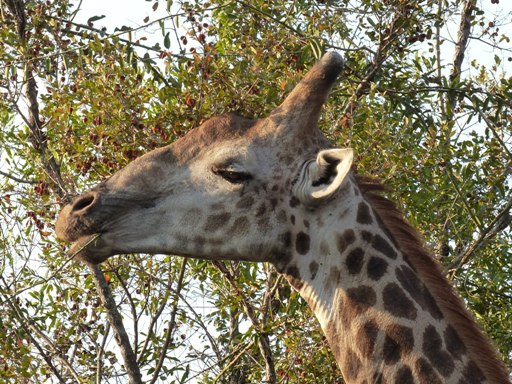
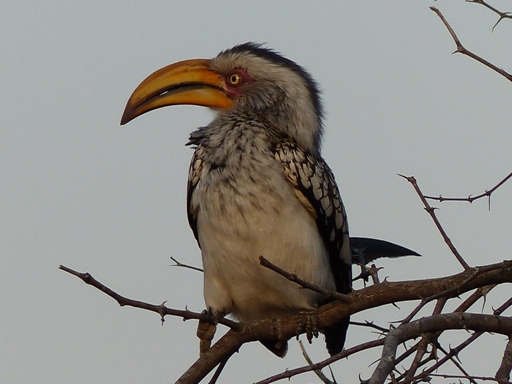
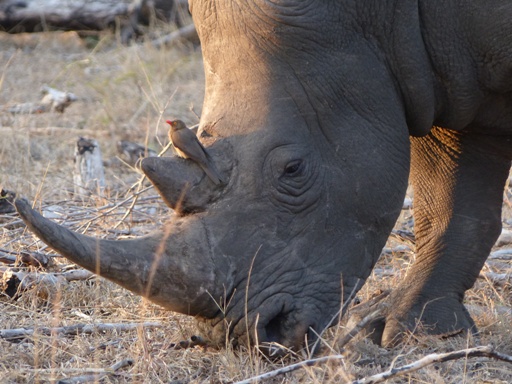
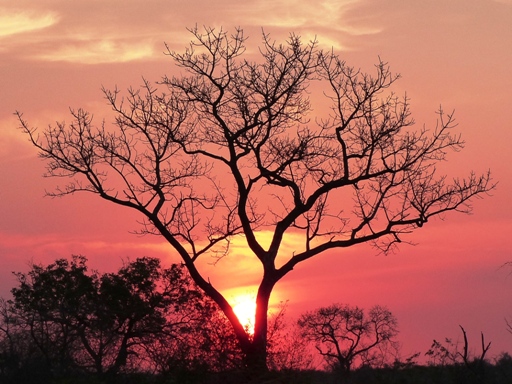
Day 3 turns out to be dominated by elephants with a big cat finish.
We awake before our 6am call for the 6:30am start to the morning game drive. We encounter the (already!) routine giraffe, impala and bush buck before locating a group of 3 white rhino. We spend a nice amount of time observing them as they wander by the vehicle getting literally close enough to touch - though naturally nobody does.
The next 2 game viewings are both even more spectacular as we spot (or at least Mauritz spots) a large herd of elephants, mothers with calves - more than 50 of them. We are able to drive right up into their midst and watch as they amble by on their way to the local water hole. We do this twice with time for a coffee and a snack in between. Superb.
We arrive back at the Lodge, have lunch and are trying to get some logistical chores done when another large herd of "ellies" make their way slowly up-river directly in front of the lodge veranda. We are compelled to have a cool beer and sit and observe them. Wonderful.
The afternoon game drive is focused on cats. Vervet monkeys are heard giving alarm calls in the distance. We speed in that direction, and some of the group catch a distant glimpse of a leopard on the opposite bank of the river (but not me). In any case she eludes our best efforts to find her. So, we do a circuit of the property looking for other game, and finding some. We enjoy the sundowner watching a glorious sunset and then continue the search - but this time with a tracker on the front of the vehicle using a spotlight. We are getting close to calling it quits when, very close to the Lodge and thus the river, the tracker gives the signal that he has spotted her. Next comes a frenzy of trying to stay with her while alerting the other vehicles to the opportunity. She doesn't seem at all concerned with our presence, and in fact is stalking some mongeese. She charges, we follow, the mongoose narrowly escapes. We then try to keep up with her through the thickets and across the ditches as she continues in pursuit of prey. After several good sightings we can follow no further.
Most or all wild animals are beautiful in their own way, but some are exceptional. There are the graceful lines of the impala, the colorful plumage of the lilac breasted roller, the majesty yet gentleness of the elephant, but, as a cat fancier, for me the leopard beats them all. This is my first leopard viewing in the wild. She is magnificent, just going about her business with unmatched speed, finesse and beauty.
Dinner is again excellent with plenty of chatter about the day's events, and a wave to the hippo in the river on the way to bed.
Rhinos and Elephants on the game drive
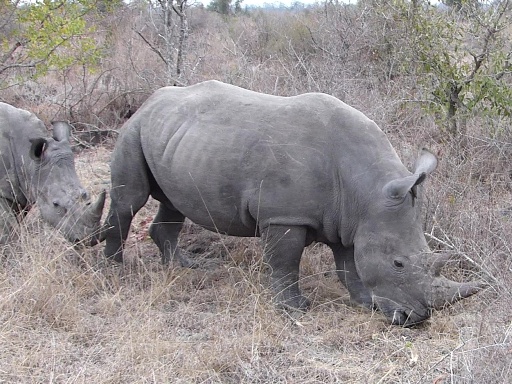
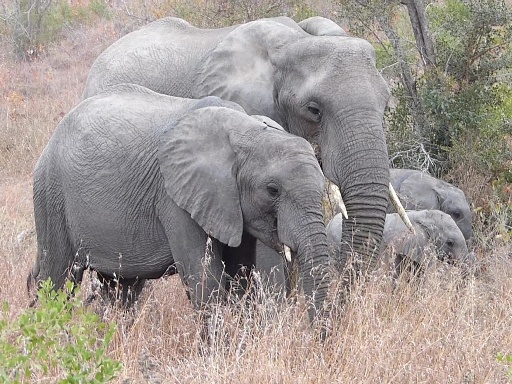
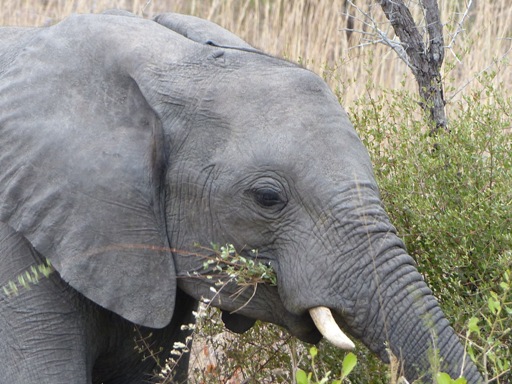
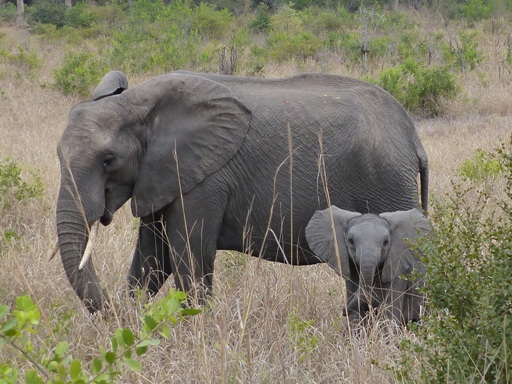
Elephants in the river below the Lodge veranda
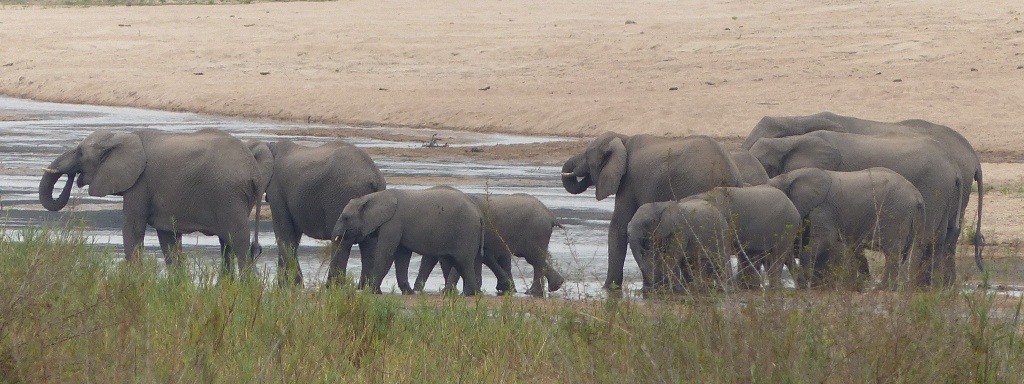
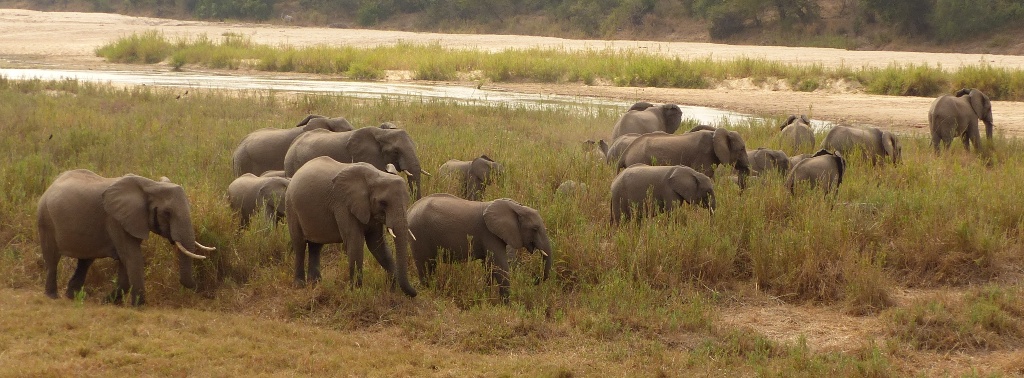
Stalking leopard - blurry due to motion and operator inadequacy (but still one of my favorites)
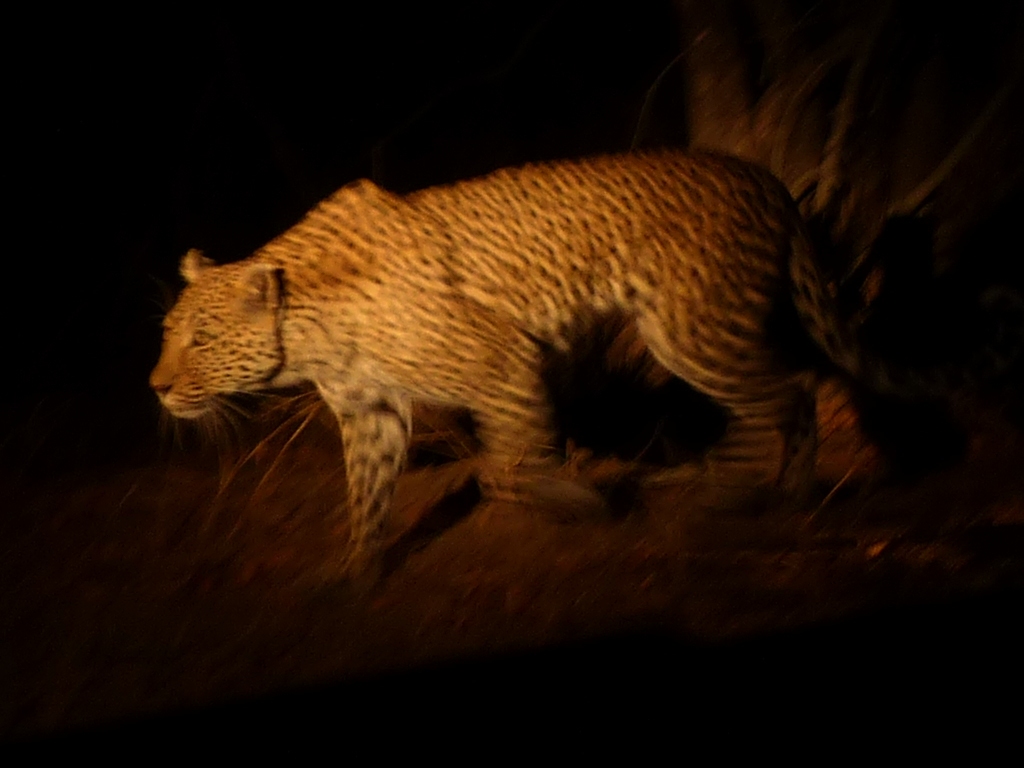
The Day 3 video features giraffe, rhinos and elephants from the game drive and elephants in the river below the Lodge veranda (duration 3:14)
Day 4
Another early start for the morning game drive. We visit with several new species including zebra and wildebeest. One highlight is watching a 2 week old giraffe with its mother. Another is an unbelievable bit of spotting by Mauritz. He spots a tiny (15cm/6inch) perfectly camouflaged owl in the crook of a tree branch from 10 meters, while driving up a tricky hill and talking to us. After he pulls the vehicle in for a closer look, it takes some time for the rest of us to see the bird from 2 meters with his help. We are flabbergasted. This guy is good.
Throughout the trip the spotting skill of the guides and trackers is exceptionally good. As a person who is a hopeless spotter (I would put myself in the bottom half of the tourists - and that is probably generous) I am intrigued by their ability. Is it natural ability, or acquired by training and time in the bush? The guides themselves agree that anyone can learn. But they also say that it really helps to have been raised in the bush. In the city we are so overloaded with stimuli that we quickly learn to focus on the thing in front of us. While in the bush you must remain aware of the items, and dangers, on the periphery. Thus bush raised children are overwhelmed when they first travel to a city and can't cope. Sometimes a guide pulls off a needle in a haystack spot (as with Mauritz and this owl) and I can only shake my head in wonder and amazement.
We learn that the collective noun for giraffes varies with motion - it's a journey of moving giraffes and a tower of standing giraffes (though a later guide says that names like this and a crash of rhino, or a wake of vultures, are just nonsense made up the the guides to entertain the tourists). Also, the reason for the stripes on a zebra is interesting. It turns out that cats see in black and white. The zebra's stripes are not mainly for camouflage. Rather, when a whole group or herd of zebras is running together, the massed stripes dazzle the predator and they don't know where to attack. Or so the theory goes.
Unfortunately no lions come to visit.
The morning game walk features another close encounter with rhinos. The same 3 individuals we had seen on Day 3 morning, but many kilometers from where we had seen them before, and this time we are on foot. We slowly circle to be downwind of them, and are able to approach to within about 30 meters/100 feet. They are aware of us and quite wary, eventually moving away. Thrilling.
It is good thing they are wary as rhino poaching is rife at the moment and their numbers are getting small - even where fences and patrols try to protect them. In fact, one of the 3 we encountered is an orphan from poaching. Apparently elephant numbers are very good - so good that there is some talk of culling, but rhinos are under threat. If the decline continues at the current rate they could all be gone in only a few years. All for a horn that has all the healing and aphrodisiac properties of fingernails. Unbelievably sad and stupid.
In the afternoon on the veranda a large group of kudu with their huge spiral horns wanders past, the go-a-way bird scolds me, lunch is served, and I finally catch up with journal writing.
The evening game drive is another unsuccessful search for lions, but I hear Maurice discuss "inguey bamba" on the radio. The guides use the local language as a code to hide discoveries from the clients, but I have learned enough to know that this means "leopard kill". We are guided to the spot where another vehicle has found a leopard up a tree with her prey, an unfortunate baboon. She is hard to see, but we retire to dinner in the knowledge that she will still be there in the morning.
The game dive vehicle and crew, including guide Mauritz and tracker Forward; two week old giraffe; small Scops owl as spotted by Mauritz with inset closeup; zebras;
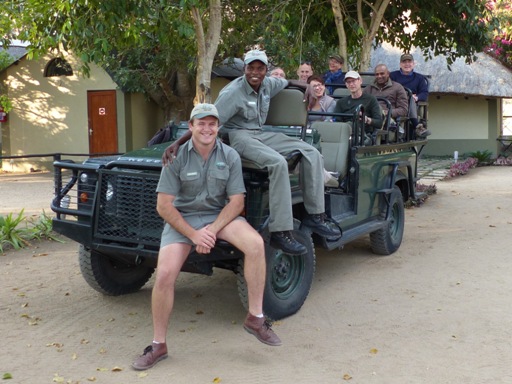
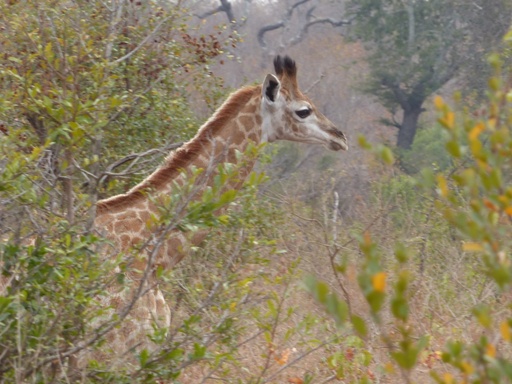
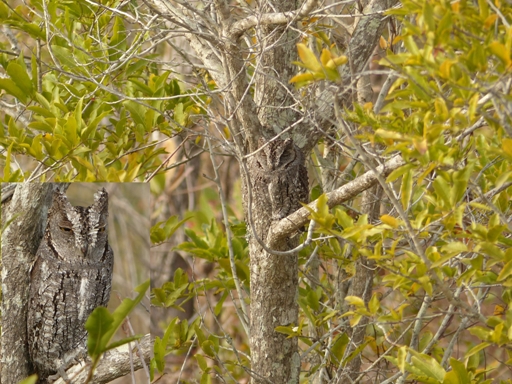
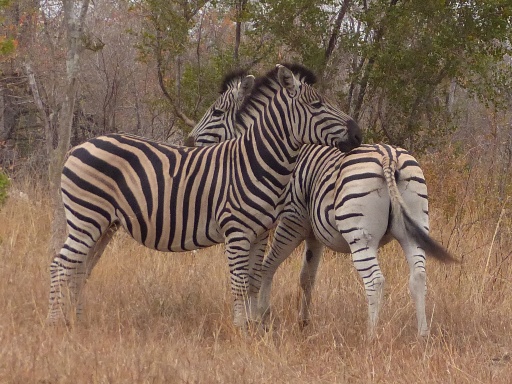
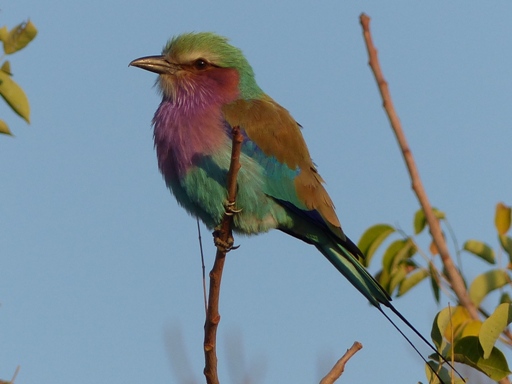

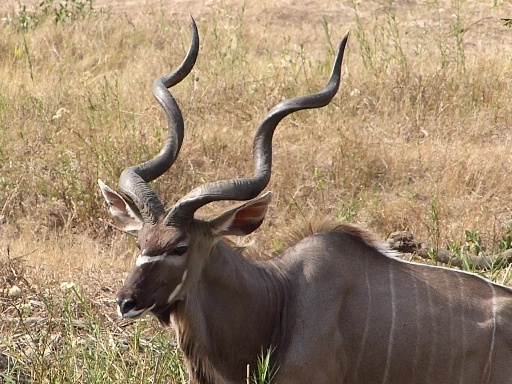
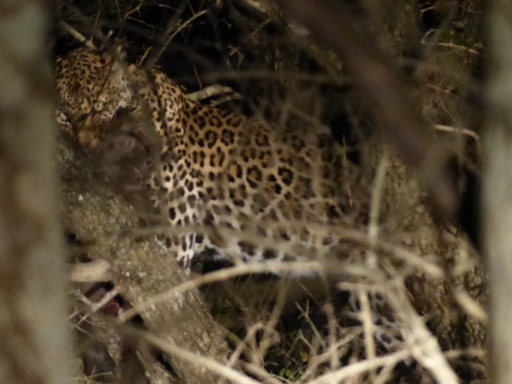
The Day 4 video is from the veranda of a group of kudu bucks passing (0:55)
Day 5 is our last day at Umkumbe in what is a fabulous start to our tour. The morning drive starts a bit early in the hope of being the first vehicle back at the "bamba", but it is not to be. Others are their first. We go exploring and hear another leopard and hyenas calling. We stop to visit a couple of giraffes (magnificent animals) while we wait our turn with the leopard. When we get there she is in the tree with her kill, and the hyenas are circling hopefully at the tree's base. She is annoyed, but lounges and poses on her perch in the tree as we get a wonderful sighting.
Then quickly back to meet our transfer to the airport to catch the flight to Victoria Falls. A couple of wandering hyena and our first sighting of cape buffalo bid us farewell.
As we are boarding Cliff is required to consider a marriage proposal from the woman helping us through security. I guess that she thinks that she and Cliff made a lovely couple, and that Victoria Falls would make a romantic honeymoon destination. Unfortunately for her, but fortunately for me, Cliff doesn't consider for very long before letting her down gently.
The flight ends with a banked left turn giving an excellent view of the falls below. After a routine trip through immigration and customs (and a $US50 visa) our transfer ride includes an elephant sighting and a crossing of the historic Victoria Falls bridge, before dropping took us at The Kingdom at Victoria Falls. (I remember being a bit excited by seeing fields full of sheep on my first airport arrival into New Zealand - but elephants are a much more impressive welcoming committee for Zambia).
Styled after the Great Zimbabwe, The Kingdom is like a piece of Las Vegas transplanted into Africa - including the casino. Having said that, it is clean, comfortable, well priced, has free wifi and a patrol of young men with slingshots to keep the baboons and monkeys at bay. Signs everywhere inform us that water is Africa's most precious resource, but the shower at the Kingdom rivals the falls themselves for volume. Go figure.
We pay a quick visit to the historic Victoria Falls Hotel next door for the well heeled traveler's view of the falls. Then a quick walk around town dodging the wandering warthogs and persistent carved wooden trinkets salesmen. Dinner of buffalo hotpot at Mama Africa's is a treat, following which we retire to make the most of that free wifi to catch up on email and world news.
The leopard in the tree guards her kill from the spotted hyenas below; Victoria Falls from the airplane; the pool at The Kingdom
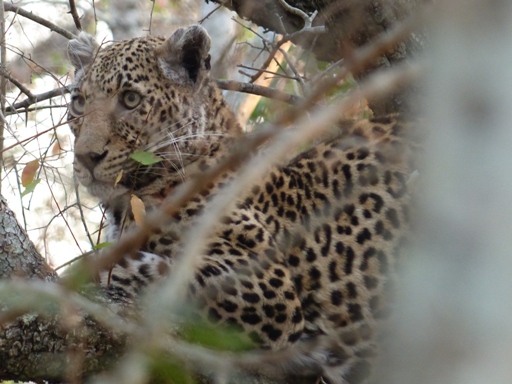
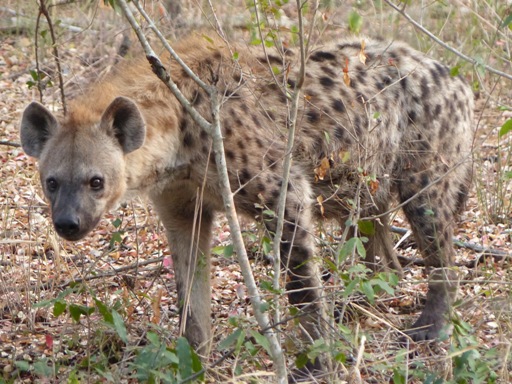
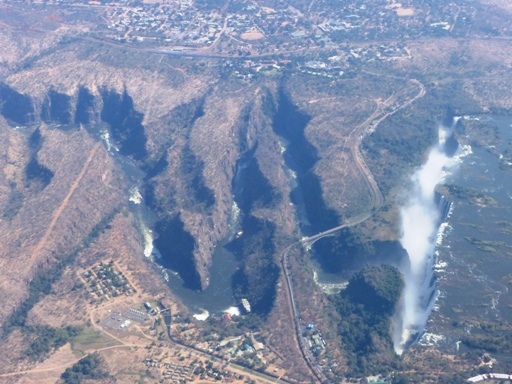
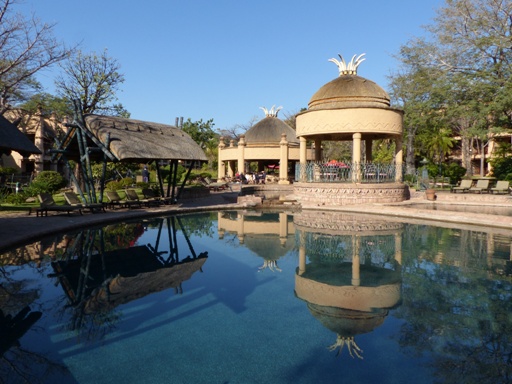
Day 6
Day 6 starts with a huge buffet breakfast at The Kingdom and ends with a similarly huge buffet dinner with local singers as entertainment. I especially enjoy the thumb piano players.
In between is the falls and some African discovery. The falls are only a 5 minute walk from The Kingdom. Once there the views and overall experience of "the smoke that thunders" are exceptional. The roar is deafening and the mist enveloping. Each viewpoint along the path shows a new vista. The way that the falls are carved into a cleft in the earth provides for a perfect viewing platform from the opposite bank.
in the afternoon I contribute to Victoria Falls' reputation as the adventure capital of Africa by taking a micro light flight over the falls. For the first few minutes as we take off, gain altitude and are buffeted by the winds, I am quite nervous and clinging on for dear life. But, as we reach the falls I am able to relax a bit and enjoy the view (though I must say that the helmet and the wind made getting a good view tricky). The last leg home over the Zambesi features aerial views of crocodile, hippo pods and elephants. All in all I am glad to have had the experience, but I'm not sure that I will rush back for another go.
I had given my camera to one of the attendants at the airport so that he could take a snap of me and the pilot before I boarded the microlight. To my surprise when he handed me back the camera it had many snaps, even a few taken in the middle of the movie he took of my take off. All this with no instruction from me except "just push the shutter button". I didn't even know that the camera allowed you to take still images while also shooting a movie! I suppose that he has seen a lot of different cameras, but even considering that, he did a super job. Well done to him.
Each walk out of the hotel results in encounters with the wood carvings salesmen. I confess that initially I found them quite irritating and aggravating. They are persistent, and I was just not interested in their wares. However, after a day my attitude has totally changed, with Cliff's help. If you start chatting with them, and engage with them, they are almost universally smiling, friendly and not aggressive. It becomes clear that they are just doing their jobs - jobs that they would rather not be doing. Unfortunately for them real jobs for young men are very scarce in Africa, and almost nonexistent in Zimbabwe. They would rather be doing anything else than chasing tourists, but they haven't much choice. They complain that they are from the Ndebele tribe and all the jobs go to people from the Shona tribe - Mugabe's tribe. After finally accepting that you really are not going to purchase their carvings, they tell you their name and ask you if you can spare some small money so that they can buy food. Or try to talk you into giving them your shoes or a t-shirt, poor buggers. The reality is that we are rich and they are needy, and that they are doing their best to make a life for themselves. I now feel real sympathy for their plight, and some shame at the time it took for this reality to penetrate my tourist armor.
While changing for the microlight flight my belt breaks. The prong of the buckle breaks clean off, making it impossible to use the belt. Can you believe it? I have never heard of a belt breaking this way, but there you have it. So, I ask the young fellow at the reception desk where he bought his belt. After a bit of confused conversation he suggests that he can have a fellow he knows come by the hotel with a selection of belts. Now I am worried. I have visions of several vendors competing for my business in the hotel lobby. I try to communicate my concerns but agree to meet the belt vendor the next morning. Later, the phone rings to let us know that the fellow is in fact coming by at 7pm. When the time comes we go to the lobby to meet Eddie. Eddie has a selection of leather belts in my nominated price range, and, in addition, crocodile and elephant skin belts. Eddie explains to us that the elephant hide is sourced legally and ethically from culling, hunting and natural deaths. Both Cliff and I become enthusiastic about the prospect of an elephant skin belt. The cost is reasonable ($35US) so we place our orders, to be delivered in the morning.
Cliff has told to me in the past that this is the way things work in Africa, but the appearance of the belt vendor calling on us within 2 hours of expressing the need to the desk clerk is fairly startling to me. Clearly everyone is very keen to do almost anything to make a bit of money.
So, a day of African adventures of the natural wonder, aerial, emotional, psychological and retail kind comes to a close.
The smoke that thunders; the historic bridge over the gorge with bungy jumper; my microlight liftoff
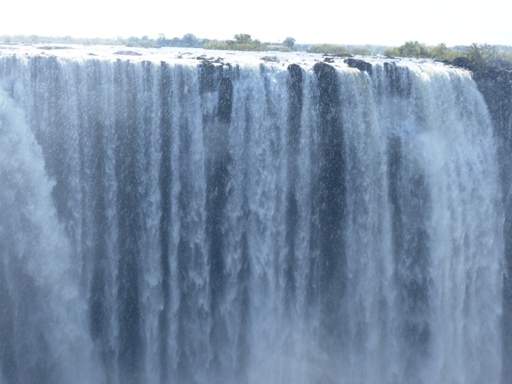
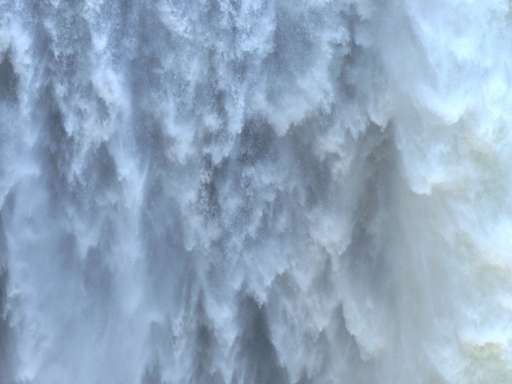
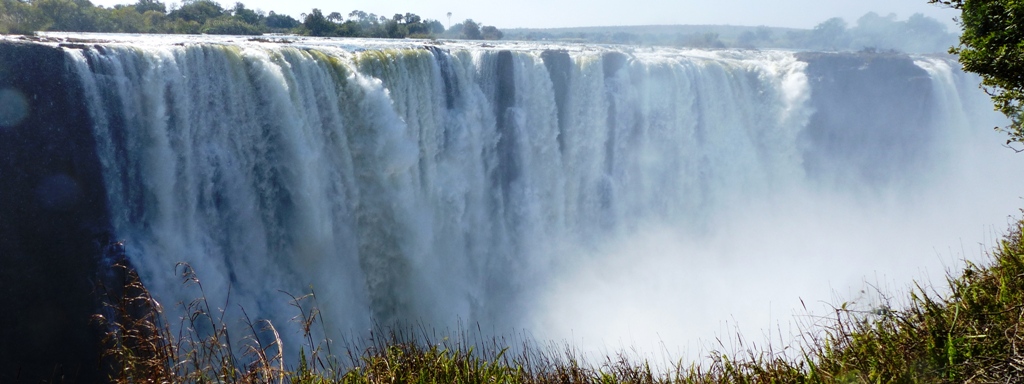
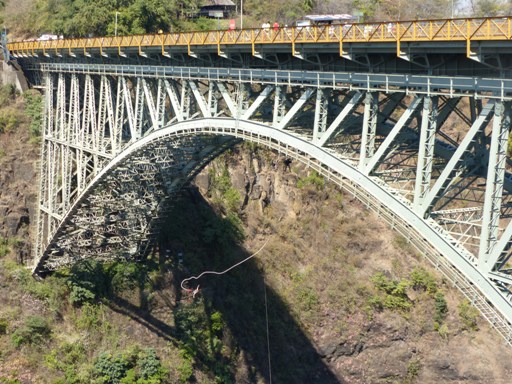
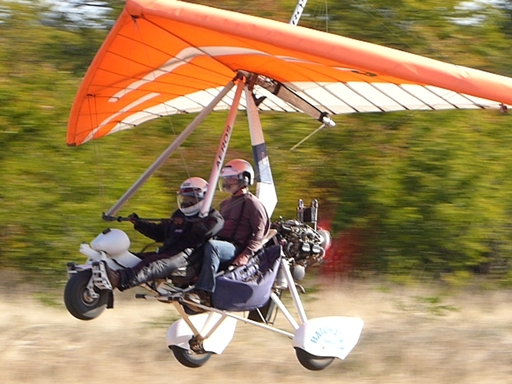
The Day 6 video is all about the mist and the roar of the falls, and my venture into the air (1:41)
Day 7
Our last day at The Kingdom begins with another sumptuous buffet breakfast, but, unfortunately not with a meeting with Eddie. He must be a busy man. However, he does drop off my repaired belt and an elephant skin belt in my size. Cliff is unlucky as no belt in his size is provided.
After a morning stroll we meet our transfer to Chobe Safari Lodge via the Botswana border.
The hour long drive to the border is through thick scrubby bush with several animal sightings and not a single human habitation. Clearly this part of Africa is still wild and empty. The border crossing is routine and we arrive at The Lodge to find the first hiccup of the trip - our reservation is somehow lost. The mistake is quickly rectified and we are shown to our room, but it is only persistence and awareness from Cliff that makes sure that we manage to catch the afternoon river cruise. Phew. Well done, Cliff.
The cruise runs along the Chobe River separating Botswana from Namibia and into the National Park. It starts in the heat of the afternoon with nice sightings of our first hippopotami and crocodiles and our first really good look at buffalo. As the day cools the elephants come to the river, and the bird life becomes more apparent. I have NEVER been in a place with more abundant and varied bird life - there are wading birds, storks, herons, egrets, ibis, cranes and spoonbills; fish eating eagles, darters and kingfishers; aquatic ducks and geese of various species; insect eaters - skimmers, bee eaters, swallows and more; and plovers, and rollers, and starlings; and various small flitting bush dwellers. The guide tells me that Botswana has 508 species of birds, and I think Chobe must have about 507 of them (though I read later in that guidebook that the correct number is "only" 450). The cruise ends with yet another spectacular African sunset, and the day ends with yet another hearty and tasty buffet dinner (including roast impala)
Yellowbill stork; white fronted bee eater; great white egret; spoonbill; cape buffalo; smiling nile crocodile; elephants and hippos; African darter shillouetted in the sunset (and one of my favoriites)
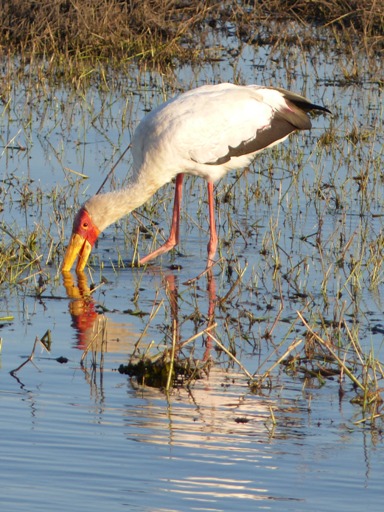
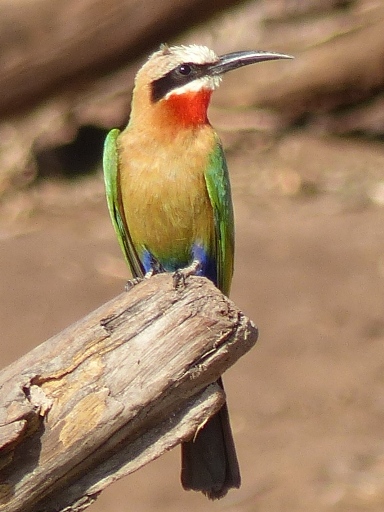
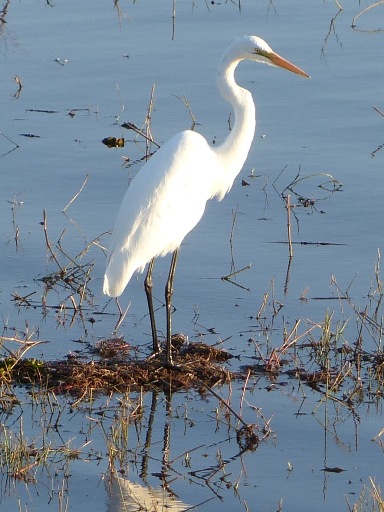
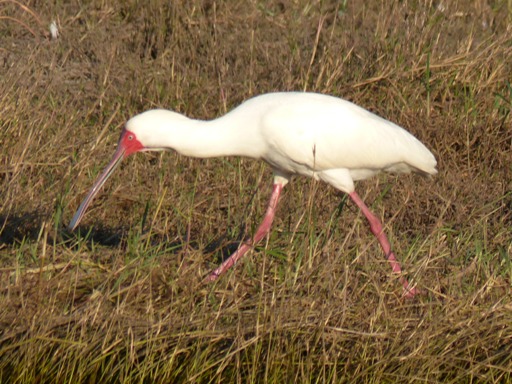

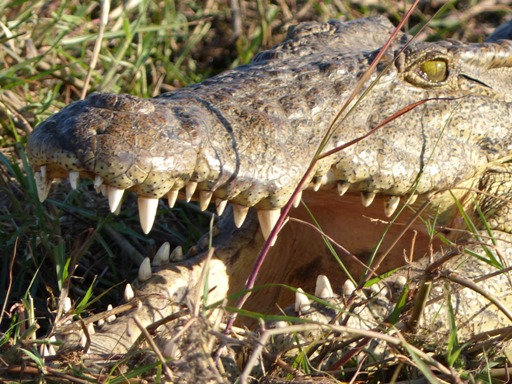
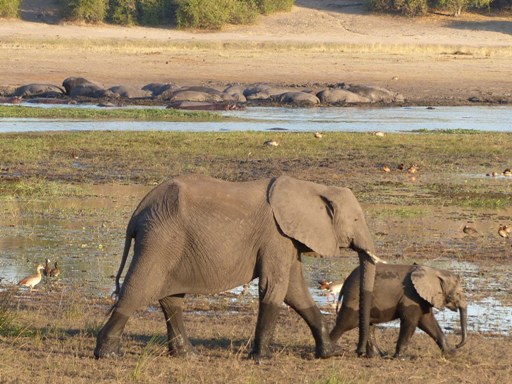
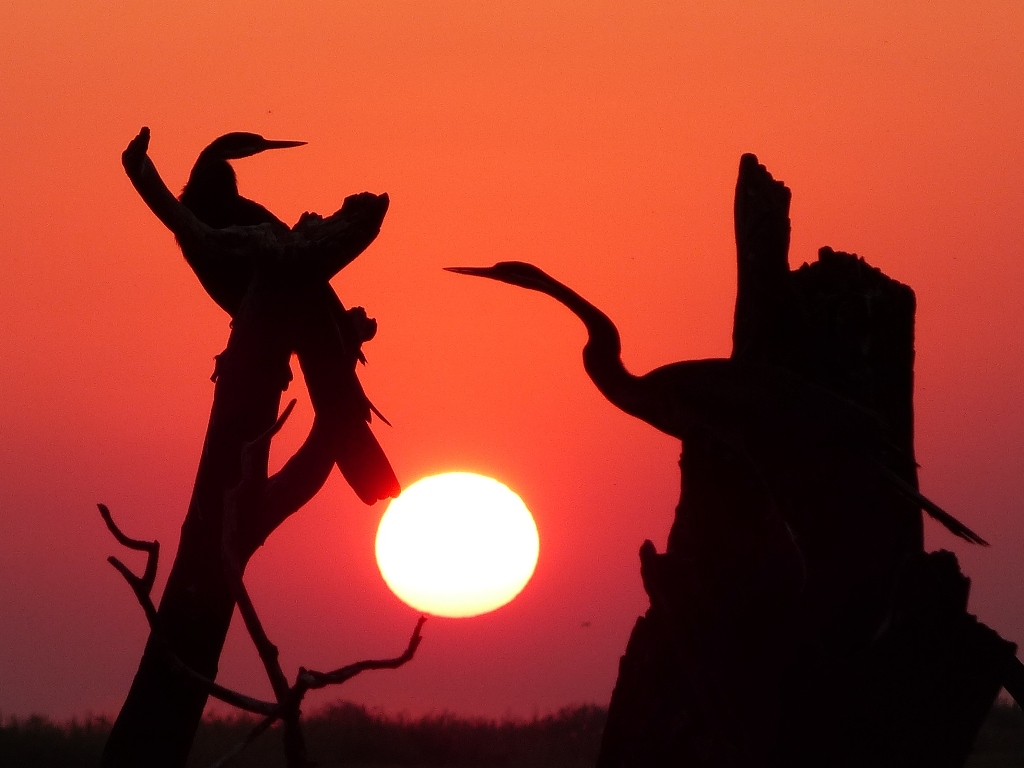
The Day 7 video is a very short clip from the river cruise of eephants along the river bank with hippos and birdlife in the background (0:19)
Day 8
Day 8 begins at 5:00am to be ready for the morning game drive. The drive vehicle and routine are very similar to Umkumbe, but the terrain is different as we follow the river upstream. The guide tells us that we are going to concentrate on cats because we can see most of the other animals better on the river cruise.
The first half of the drive is uneventful, but, then word comes over the radio of a lion on the prowl. We arrive at the sighting just in time to catch a fleeting glimpse of a lioness, but she soon turns away from the road and we cannot follow.
An aside - seeing this lioness means that we have completed our set of the "Big 5" of Africa - being lion, leopard, elephant, rhino and buffalo. The notion of the Big 5 originated in Victorian times as the 5 most dangerous animals to hunt. However, today's tourism promotion in Africa is still heavily focused on seeing the Big 5. There are many spinoff 5s - the ugly 5, the little 5, the green 5, and so on. This seems completely bogus to me, but is fully entrenched, with a concentration on "bagging" the Big 5. What about the hippo, giraffe, zebra, gorilla and all the others I ask? What about actually having some time to experience a visit with any animal? Seems a pity for the hunting legacy to be perpetuated in this way, but there you have it.
After a quick cuppa, the return half of the drive features close encounters with a large flock of impala, a roosting vulture, a troop of baboons, the rare sighting of a sable antelope and a quick glimpse of a honey badger. A large bull elephant greets us as we return to the Lodge for breakfast (including impala sausage).
We manage some quiet time and a bit of wifi before the afternoon's cruise.
The afternoon is perfect for the river cruise - warm and sunny to start then cooling as the sun dips, with little wind. The weather for this trip has been flawless. We have had crisp cool (sometimes cold) mornings followed by sunny warm days with never a cloud and never a threat of rain.
It is the dry season that brings the animals to congregate at the river. Apparently this year they have not yet arrived in the very large numbers that will come in August and September. For example, we are seeing herds of tens of elephants rather than the hundreds that Cliff has seen in previous visits.
The dry season has another advantage in that I have seen only a handful of flying insects and have no bites at all. We sleep under mosquito nets each night as this is malaria country, but there seem to be no mosquitos. Hurray.
Every excursion provides a different set of highlights. You never know what to expect, but something good always happens. We travelled the same stretch of river yesterday, but today's cruise features different sightings including a fish eagle feeding, wallowing hippos, and a bit of trunk wrestling between two young bull elephants.
At the evening buffet I reaffirm my role as top predator by completely loading my plate with the flesh of dead animals (with a token spoonful of vegetables). The menu features a very nice spicy beef worst, impala chops (medium rare), roast warthog with mustard sauce, and fresh river bream. Yum. Dessert is chocolate mousse, mediterranean sorbet, mixed tropical fruit frozen yogurt, and avocado (yes, avocado) ice cream. Yum.
Fleeting glimpse of a lioness; alpha male impala with his herd trying to scent out the strangers; whitebacked vulture looking for a feed; fish eagle feeding; marabou stork


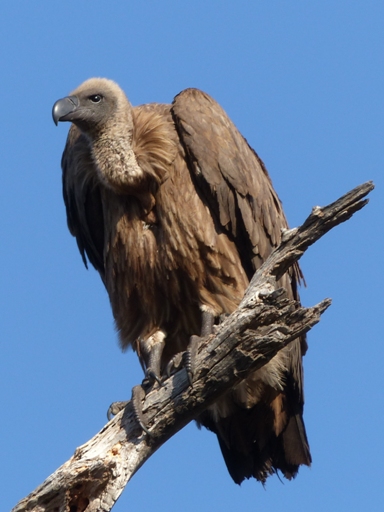
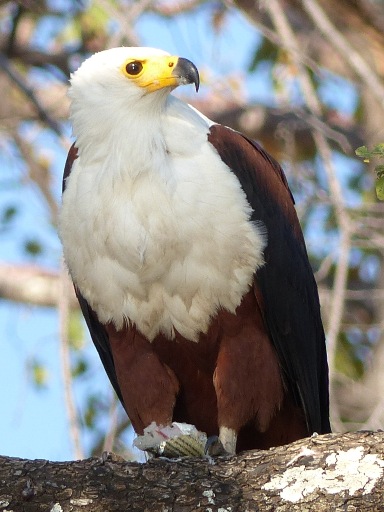
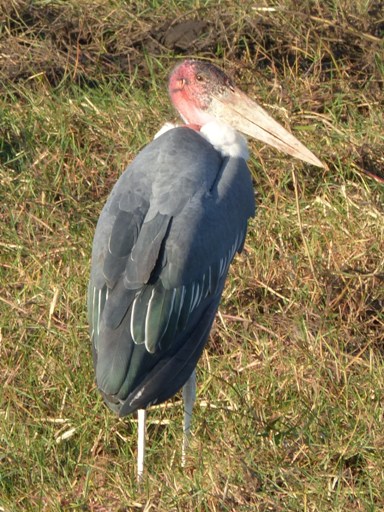
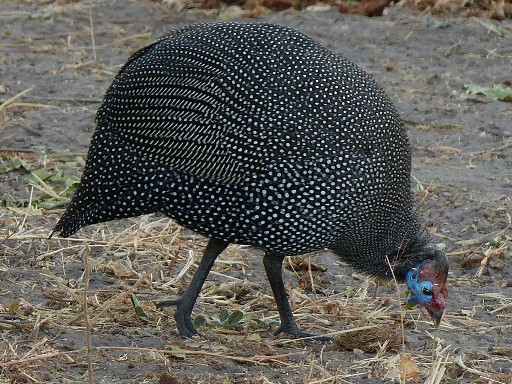
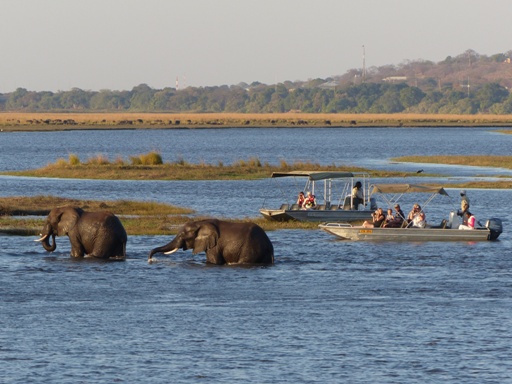
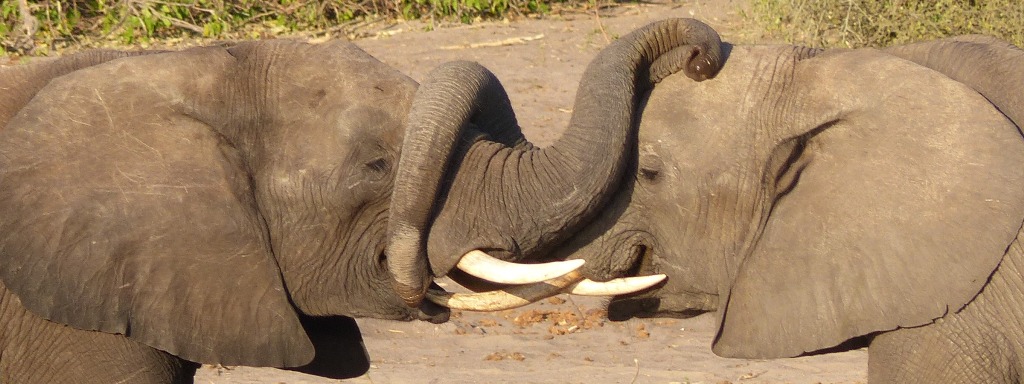
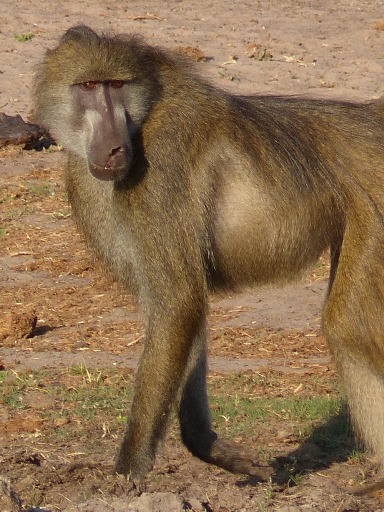
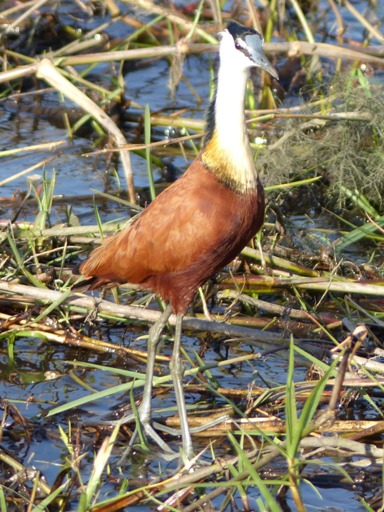
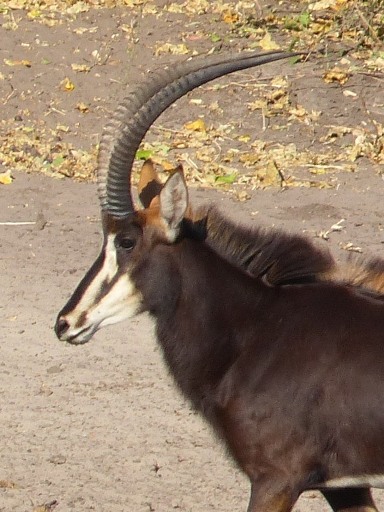

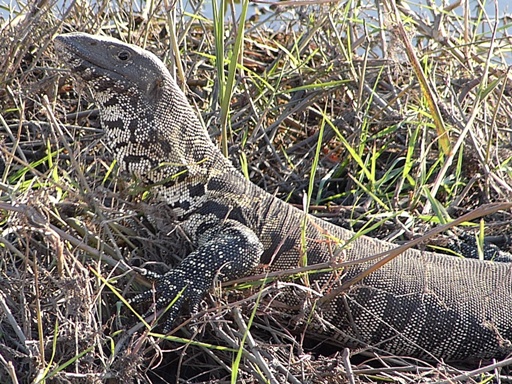
The Day 8 video is entirely scenes from the afternoon river cruise, and so has a background of chattering tourists. Scenes are: elephants cleaning their food and eating; monitor lizard; baboons coming down for a drink; a social group of elephants by the river; hippos feeding (4:52)
Day 9
Yikes. The trip is one quarter over already. It has gone very quickly and been action packed. Every day has provided something new and fascinating.
We have a lie-in this morning as we opt not to sign up for the extra game drive. This gives us a chance to catch up on email, photo sorting, and guidebook reading in preparation of the remainder of the trip.
The walk to and from breakfast provides our best warthog and vervet monkey sightings yet, with a monitor lizard thrown in for good measure.
As we have the day free we walk into the local village, Kasane. We check out a few shops including the bottle store, supermarket and curio shops. The bottle store and supermarket are very tidy and well stocked. They are at least the equivalent of what would be found in a New Zealand town - right down to a large selection of cosmetics and camembert cheese. The prices are on a par with New Zealand, or perhaps a bit cheaper.
The village itself is probably about what you imagine; dusty with small cinder block and wooden houses. Keeping chickens or a garden here is not practical due to the wandering warthogs and other native animals. The cars are modern and well cared for - no junk piles or rust buckets here. The people are very stylishly dressed. I'm talking leather boots and colorful neck scarves for the women and slacks and dress shirts for the men - no rags here. Admittedly Botswana is a prosperous country by Africa standards (thanks to diamonds, cattle ranching and, increasingly, tourism), but none of these people would look out of place in any modern city. They do seem out of place to me in this fairly basic rural village, but then Africa is full of surprises.
My impression from the places we have visited so far is that even when the infrastructure is third world, the cars and the people's appearance, grooming and attire are first world.
During the afternoon on the veranda the vervet monkeys are at their entertaining best. One sneaks onto a cruise boat, raids the loo for the toilet paper, and proceeds to TP the boat and local trees! They chase each other all around with exceptional acrobatic skill and carefree attitude. More fun than a barrel of monkeys.
The afternoon river cruise again is along the same path, but again features new experiences. This time we sight a large journey of giraffes (they were moving); a pod of hippos playing around in the river; and a family of elephants silhouetted in the sunset.
You are no doubt bored with descriptions of the buffet by now, so here are some pictures.
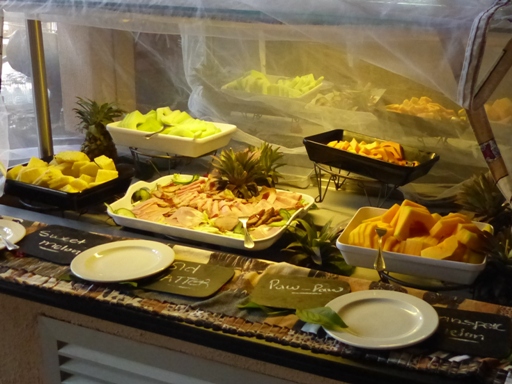
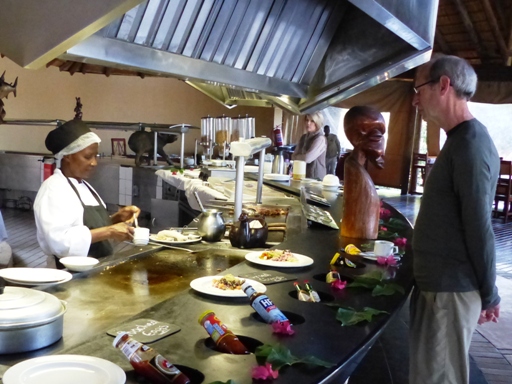
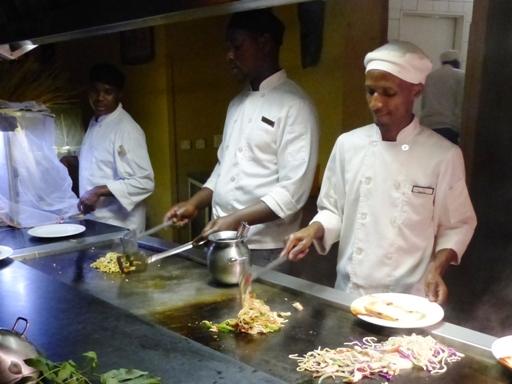
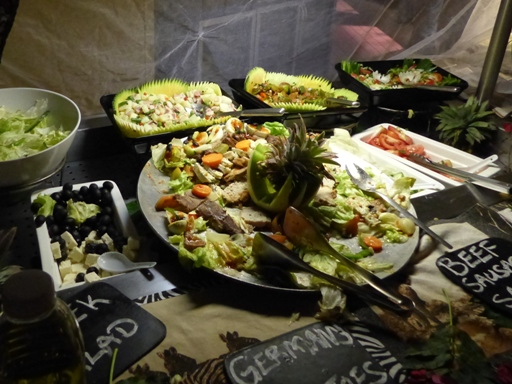
Scenes from the day: warthogs; adult vervet monkey; skimmers; hippos; squacco heron; young vervet monkey; African darter showing why it is the snake bird; giraffes; white faced whistling duck
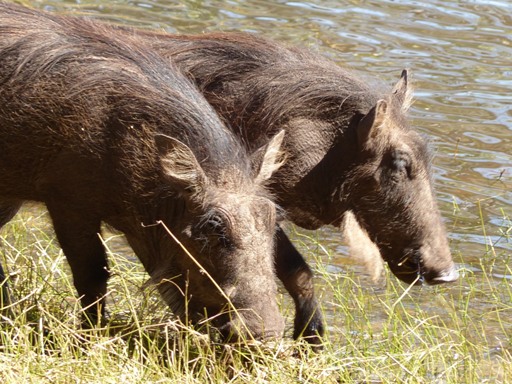

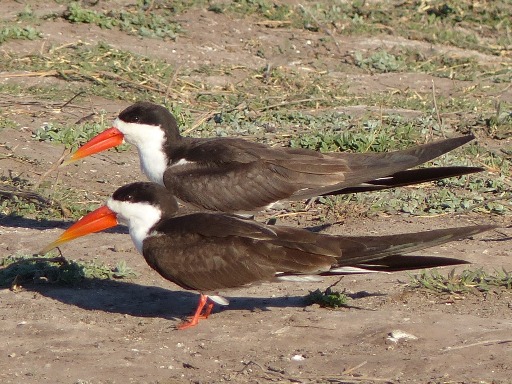
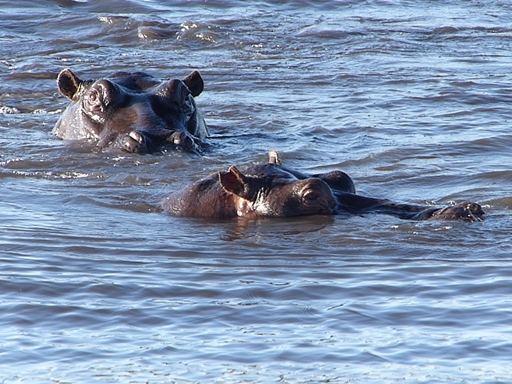

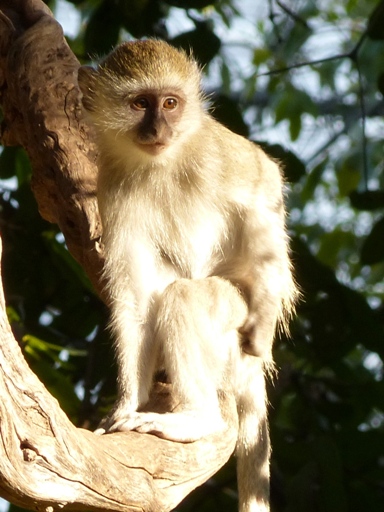
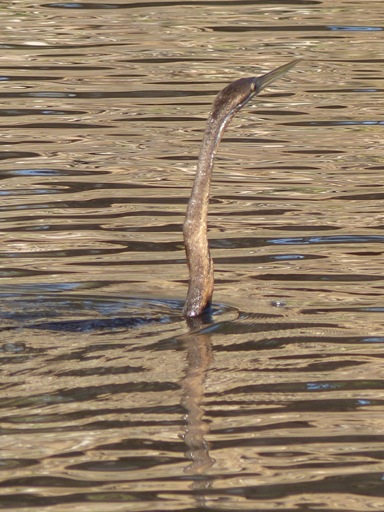
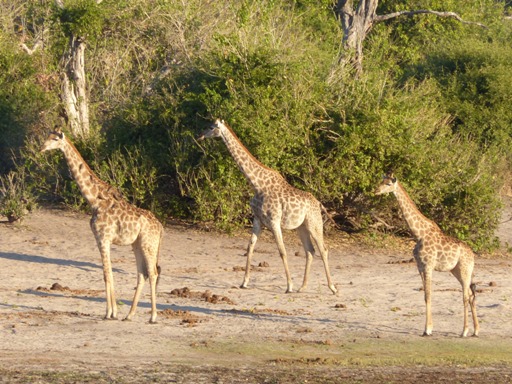
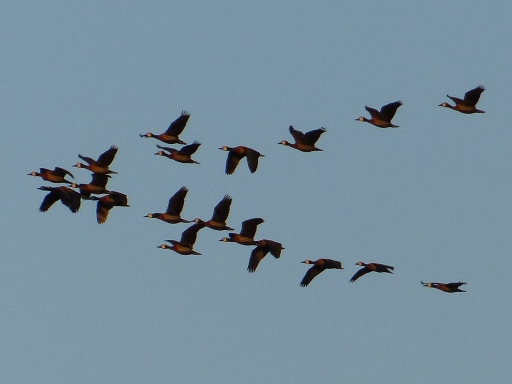
The Day 9 video is a sequence of short scenes: monkey business; buffalo; crocodile; baboon; hippos; giraffes (3:40)
Day 10
Day 10 starts with a very busy morning. We are up and packed by 6:30am to catch our 7am private boat cruise and be ready for our 9:20am transfer to the airport.
The private cruise is just Cliff and me in a smaller boat. As most larger animals have not yet congregated by the river at that time of day, this cruise is focused on the birds. The guide, Mike, keeps encouraging us to photograph the birds in flight, and we have many opportunities with many species, but this is really, really hard to do. Our cameras make some tasks easy, but trying to find, frame, follow and focus on a flock in flight is formidably, fearsomely, famously fraught with difficulties. Fortunately, we get some good stills, and bits of video. Cliff specifically requests that Mike find us a malachite kingfisher (a beautiful little bird), which he does, and we are late back to the dock as we sit and watch two of them perched in the reeds fishing and preening.
Then back to quickly check out and find that our transfer had been delayed long enough to make one last visit to the breakfast buffet. Hurray.
The flight to Pom Pom Camp in the Okavango Delta is in a 6 seater plane, but smooth and easy. It turns into a flight seeing expedition as the pilot follows the Chobe River for the first section, giving good game spotting from the air of the animals we have seen from the vehicles and boats. The bulk of the flight is over a dry, scrubby plain, which is dotted with waterholes and everywhere crisscrossed with networks of animal tracks. (The Botswana currency is called Pula, which I have learned means rain in the Setswana language. Which makes sense for a dry land like this.)
As we near the delta there was a fairly sudden change from dry everywhere, to dry with river channels, to wet with dry islands, but the animal tracks remain present in all environments.
A staff serenade welcomes us to the Camp. We are in Tent 1 at the edge of the compound overlooking the lagoon. As with Umkumbe we are under strict instructions not to walk between the tent and the lodge after dark without an escort. This is due to the danger from wild animals, mostly elephant, buffalo and hippo. In fact, this is the only hotel stay I have ever had where the room comes equipped with a compressed air hooter to signal the staff in case of rogue elephant attack, or a lion wandering past!
The lagoon laps at the base of the tent's veranda, but there is not a biting or buzzing insect to be found. Remarkable how there can be that much still water everywhere and no bugs, and a real pleasure to not be hassled or threatened with disease. Our guide L.T. (short for Lion Tracker) says that it is too cold for bugs, but I know that at a similar temperature at home I would be swatting them. So perhaps insects acclimatize to their environment in much same way as people? You will be familiar with the thin blooded sensitivity to cold of people who live in warm climates. When walking in Kasane in our shorts and t-shirts most people were dressed in winter jumpers/sweaters and heavy coats. Maybe mosquitos are the same? Seems unlikely, but whatever the reason, we don't miss them.
This is our most luxurious accommodation and the tent, while made with fabric walls, is in fact a very spacious and comfortable cabin. The shady veranda is perfect for catching up on journal writing while admiring the view of the lagoon and listening to the birds and hippos call.
The afternoon game drive follows a generous afternoon tea. We travel slowly along the dusty dirt tracks that are by now familiar. No spectacular sightings eventuate, just a very pleasant outing. Probably most memorable is when we discover lion tracks, and then watching the guide and tracker eyeing the ground along the vehicle tracks. By doing a full circle we are able to determine that the lions are somewhere in the ground we enclose. They remained hidden. At the sundowner we watch a male impala try to get amorous with one of his harem. She kicks up her heels (literally). Perhaps sunset is a time of romance for impala too? But not in her case.
As there are only 8 guests in the Camp for dinner, the staff prepare a special treat. They serve our meal in a treehouse in the bush overlooking the lagoon. On a still and starry night, with a magical serenade from the frogs chirping in a chorus like the tinkling of a marimba, with excellent food, and the laughter of new found friends, this is an evening that will not soon be forgotten.
Each night, when we get back to the tent we find a hot water bottle in our beds. It isn't really all that cold, but the warmth makes the place even cozier.
Wire tailed swallow; buffalo; warthog; fish eagle; 3 kingfishers - pied, malachite, striped; lion footprint; red lechwe; the seats on the shady veranda; sunset
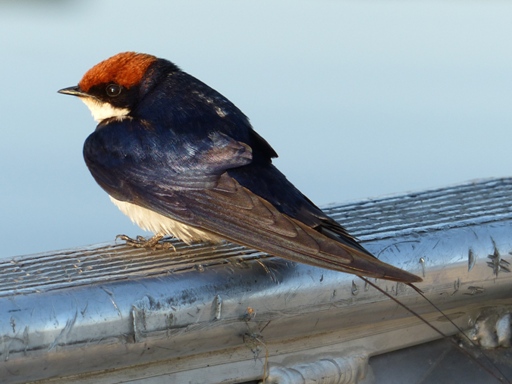
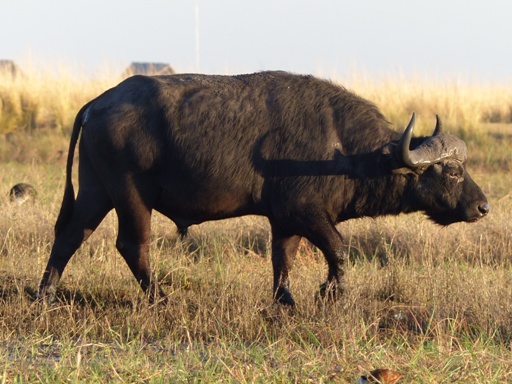
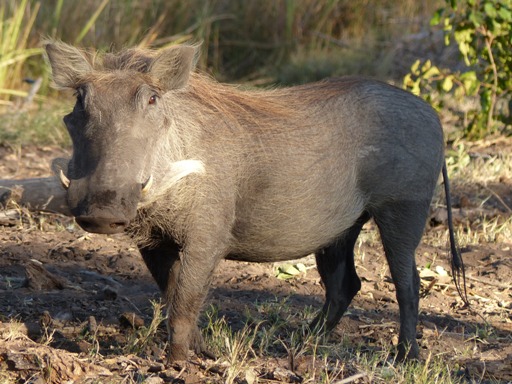
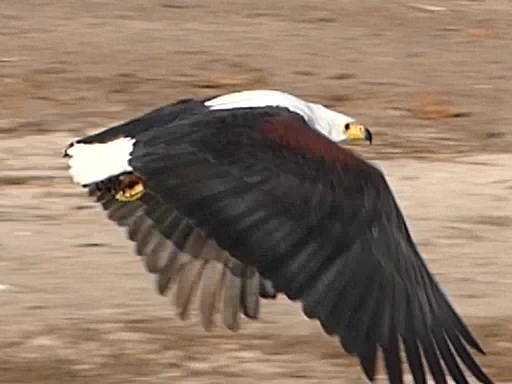

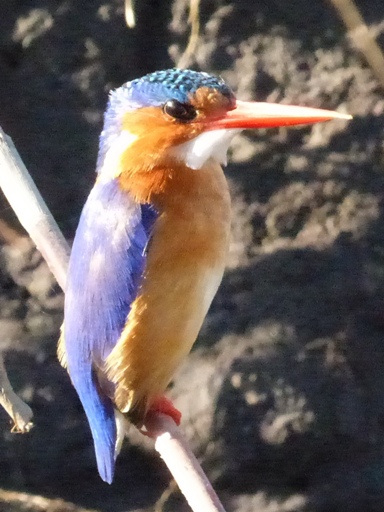

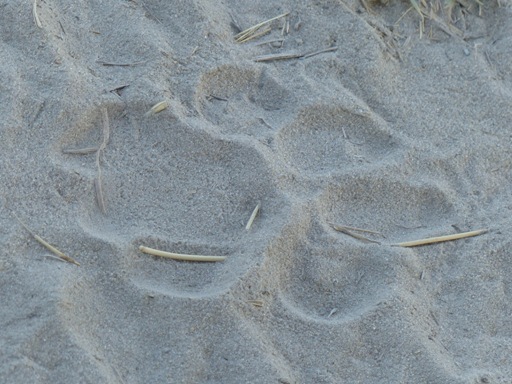

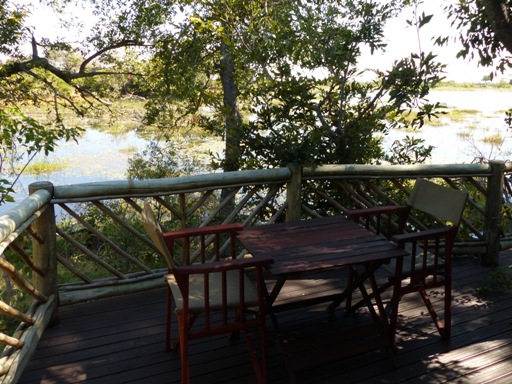
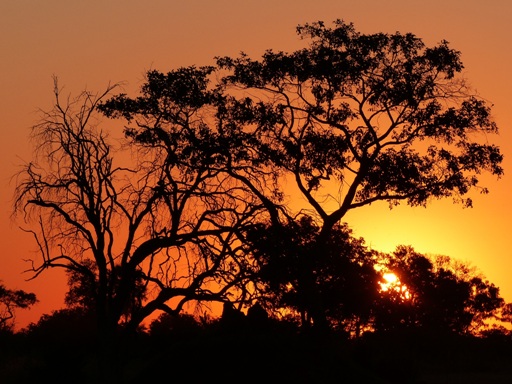
The Day 10 video is a fish eagle in flight; hippos feeding; and the malachite kingfsher (2:29)
As a bonus you should check out this clip of a sound recording of the sounds of the lagoon at sunset - including those chiming frogs and some hippo calls - one of my favorites - turn it up! (0:57)
Day 11
Each day at Pom Pom begins with fresh coffee and milk delivered to our tent with the 6:30am wake up call. Then follows a warm outdoor shower, and a light breakfast. This morning's activity is a walking safari - just Cliff and me with the guide, Max, and tracker, Allen. We have a nice giraffe sighting on the way to the walk and while walking learn much about the smaller things that don't get considered on game drives. We discuss animal tracks of course, but also grasses and grazing, trees and scrubs and their traditional uses, and ask questions galore. They show us how to make the type of snare that they had used as boys to capture "bush chicken". And who knew that you could eat the seeds of the sausage tree and also use the sap for penile enlargement (in the days before Internet spam). They also teach us the three part African handshake - normal, up to enclose his thumb in your hand, then back to normal. Fun.
Brunch is ready soon after our return, with the hippos very close into the shore. Then some quiet time back on that shady veranda.
Talking with the guides is always interesting, and whenever more than 2 or 3 of them get together the amazing tales of close encounters with wildlife get told. There was the time we found the lion kill in the center of the Camp lobby; there was the time we pulled up at this bridge and saw lion, leopard, rhino and elephant in the same view; there was that time we watched the male lions fighting for dominance; and so on. I'm not quite sure if it is a game of one-up-man ship for the guides, or an effort to convince the tourists that they might get an amazing opportunity too. In any case, it is a bit of fun to watch and listen.
The afternoon turns out to be one of wishes come true and surprises.
We opt for the motorboat cruise accompanied by our new friends Ray and Betha. Ray has already adopted Cliff as his Africa mentor and we make a congenial group. Our guide, B.T. (short for Best Tracker he suggests with one of the world's biggest smiles) winds us through the channels of the large wetlands that branch off of our lagoon. The cruise is relaxing and fairly "pedestrian" until we encounter a family of elephants along the shore. The mother and daughters are soon joined by the largest bull we have yet seen. We drift on the current, giving us the perfect vantage point for watching them wade in the shallows and feed. It is so nice that we decide that it is time for the sundowner, even though the sun is still up. Ray takes charge and provides a generous pour.
Now, Cliff has had a long held dream of sitting with friends in the evening while sipping a gin and tonic and watching elephants. Presto, time for a new dream, Cliff.
As we relax and congratulate Cliff, B.T. spots a second group of elephants headed our way. Ray's range finding binoculars tell us that they are about 500 yards/meters away. Wouldn't it be great to get elephants silhouetted in the sunset says Ray, but B.T. says that they have turned in a different direction. Well, they must have turned back again because not long later we spot them headed for the river in front of us. Presto, we cruise forward and watch the lead bull swim the river in front of us with the setting sun behind. Magical.
We speed back to the Camp to beat the falling light. Cliff and I head for our tent, only to be told when we are fetched for dinner that we have missed a leopard sighting. Bugger. She was seen very close to Camp explains Ray as he happily shows us his photos.
The dinner menu includes Pom Pom Surprise for dessert. The surprise turns out to be on Andy, the Camp manager. The staff has prepared a surprise birthday party for him including a cake, presents, and lots of singing. Delightful. It is his thirty tenth birthday. They are clearly a close group. Nice.
Giraffe; the shady veranda as seen from the lagoon; water lily in the lagoon; sausage tree; big bull elephant; hippo in the lagoon very close to the Camp; fish eagle nest; elephant crossing the river at sunset
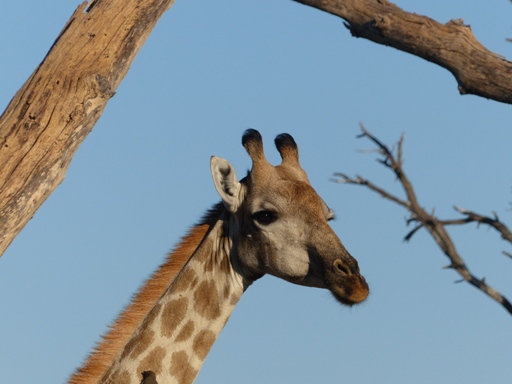
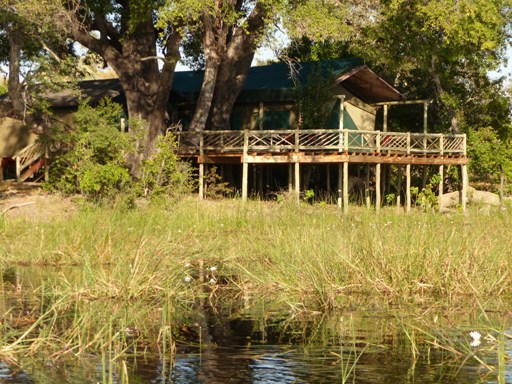
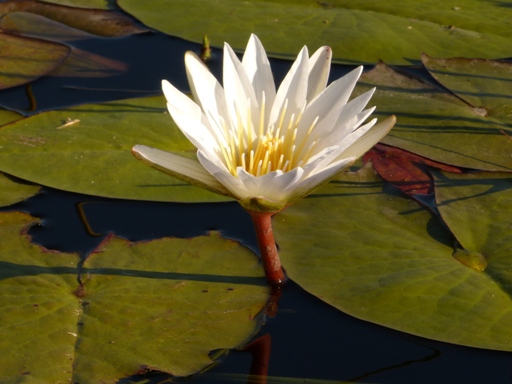
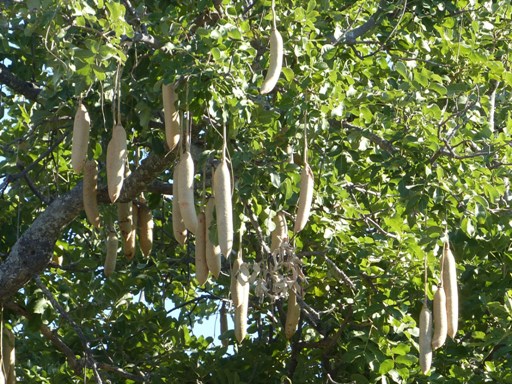
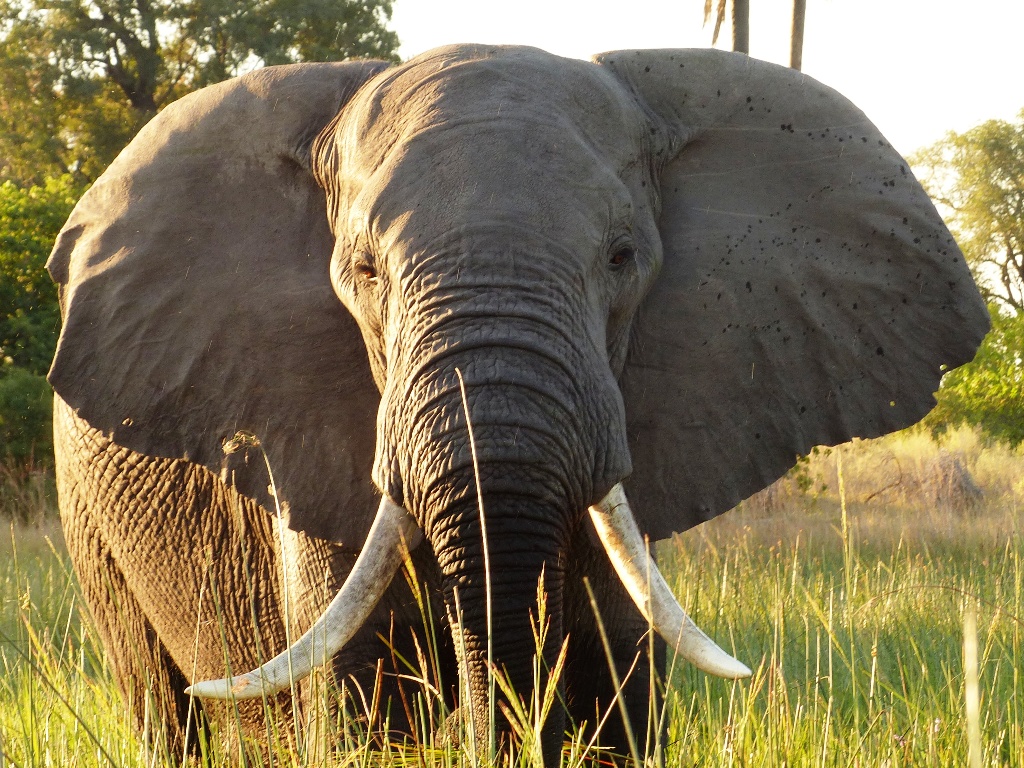
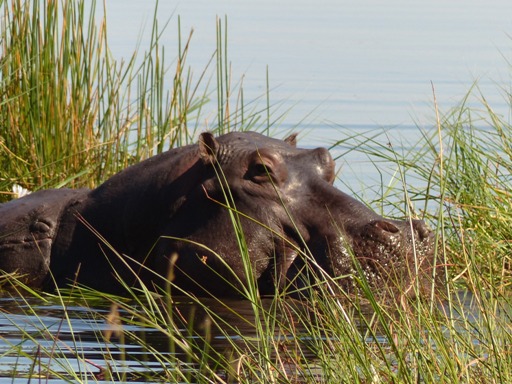

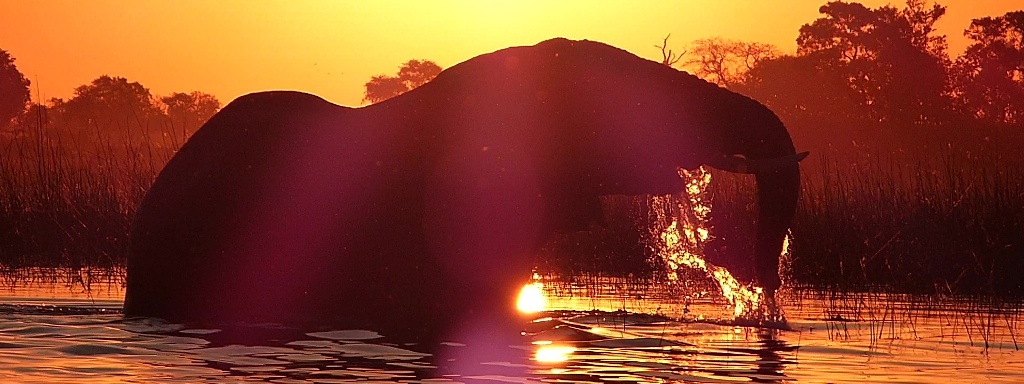
The Day 11 video is entirely scenes of the elephants that Cliff, Ray, Betha, B.T. and I saw on the lagoon boat trip (2:46)
Day 12
The morning game drive is all about the previous evening's leopard. We follow her tracks this way and that, eventually locating her to an area of grasses, reeds and bushes by the water's edge. We can tell that we are close by the obviously nervous behavior of the impalas, closely grouped and very watchful. But, she chooses not to be seen.
Still, there is no such thing as a dull game drive and we have a nice visit with journey of giraffes, and coffee next to a 500 year old baobab tree. It turns out that you can tell the age of a baobab by getting a group of people to join hands and circle the base of the tree. Then multiply the number of people required by 100. The biggest, oldest trees in the Kalahari require 35 to 40 people for this task.
After a relaxing afternoon in the shady lobby we enjoy a relaxing boat cruise watching the kingfishers hover and dive, and trying to frame the perfect sunset reflections. I opt to remain in the lobby for cocktails before dinner, so when the second leopard sighting in as many nights occurs, we are able to send a quick messenger to fetch Cliff.
One of the returning game drive vehicles has nearly run her over on the road near camp. She is the daughter of yesterday evening's visitor. As we arrive she had just treed a genet cat. It is too high up in the tree to reach, so she down-climbs and starts to prowl. Even with two spotlights we struggle to keep her in sight. Eventually she gives up, probably in frustration at our presence. She sits and looks bored, never deigning to give us so much as a glance. We watch for a few minutes hoping she might prowl again, but eventually have to return to Camp for dinner.
As we are in the dark of the moon, the sky is star-filled on the walk back to the tent. Awesome.
Group of impala on the wary lookout; greater egret takes flight; lagoon reflections and the 500 year old baobab with tourist in safari colors for scale; the tail and head of a leopard showing the difficulty of spotting at night; an irritated leopard; a treed genet cat (looking relatively reaxed for an animal in the spotlight while being chased by a predator); the milky way and southern cross as seen from the shady veranda
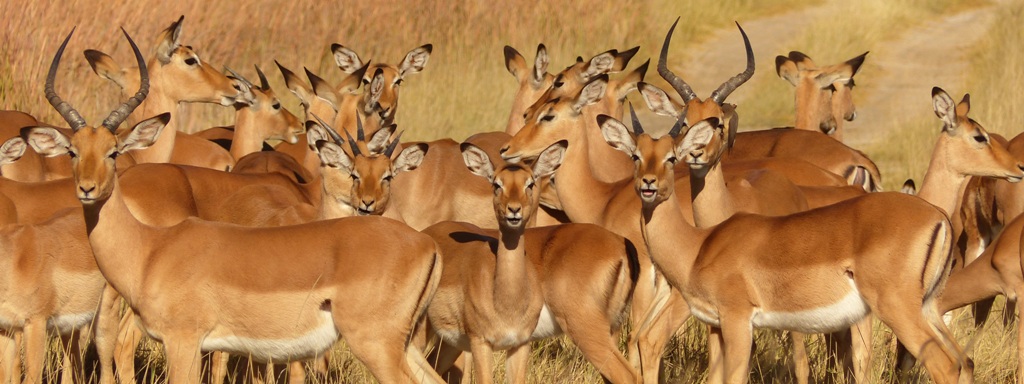

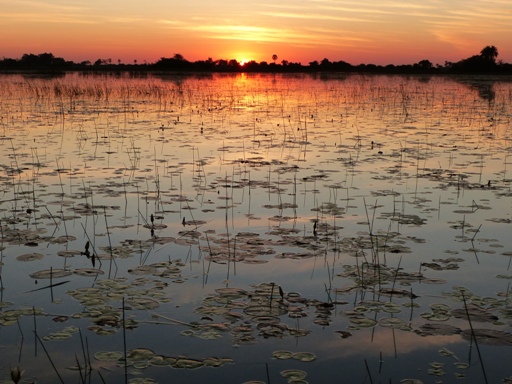
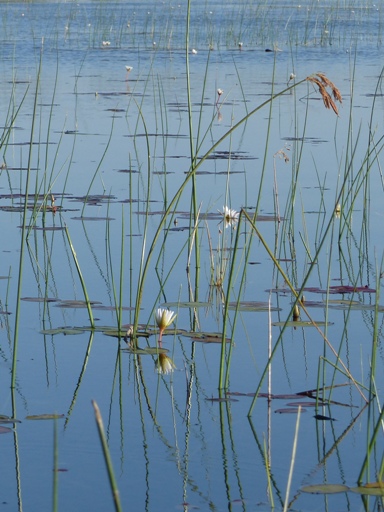
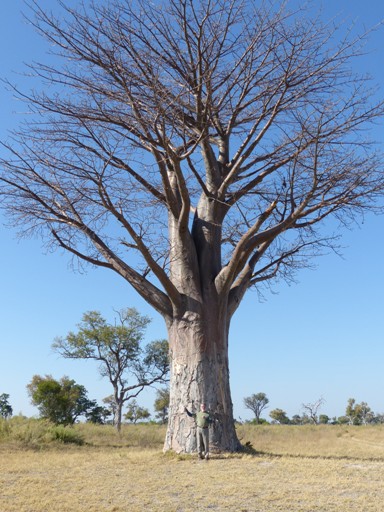
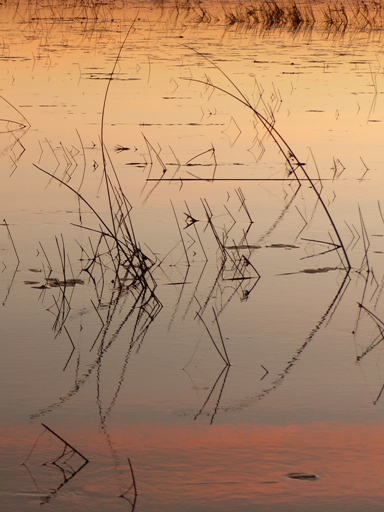
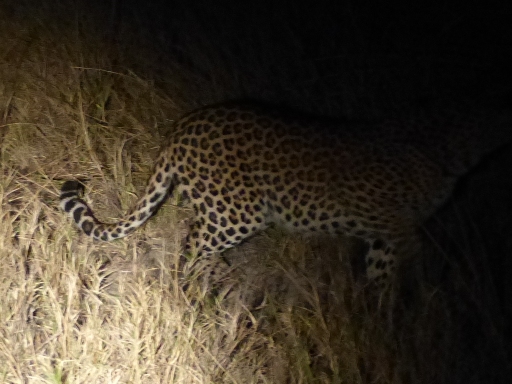
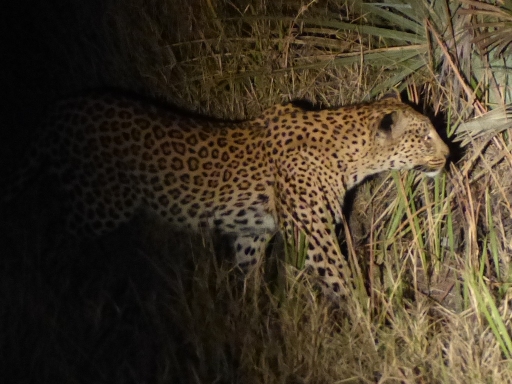
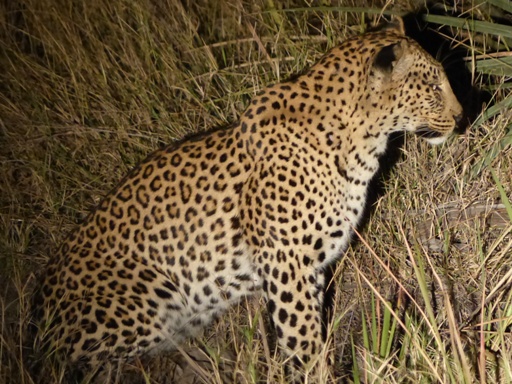

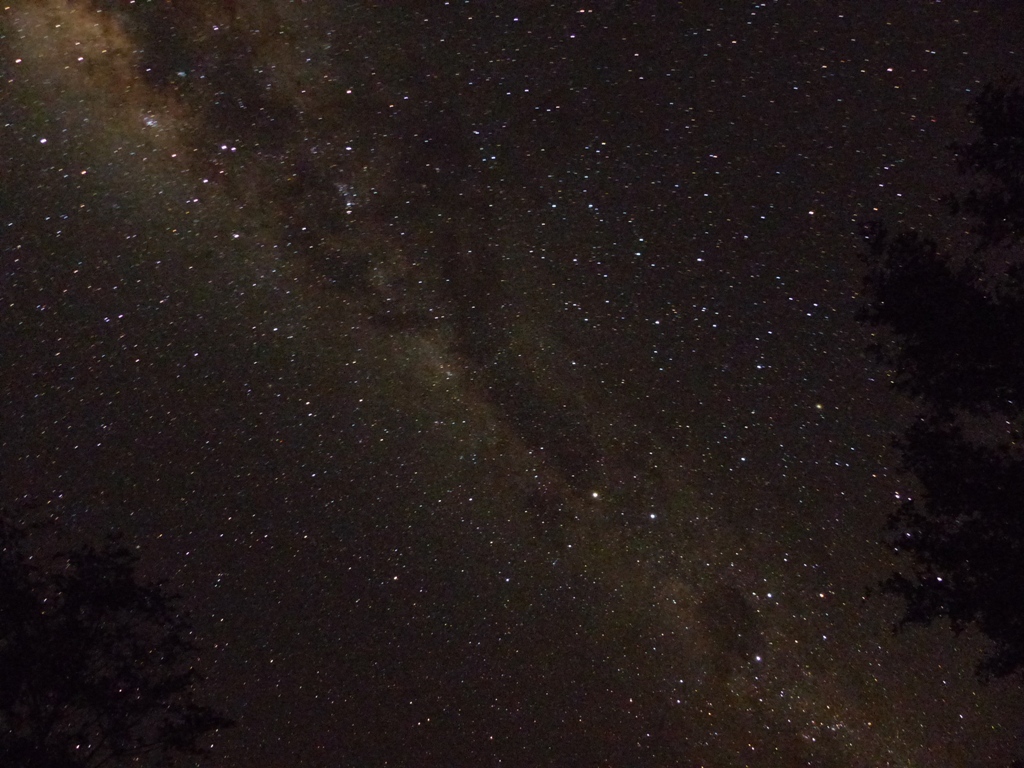
The Day 12 video is a giraffe's breakfast with cackling crows and a hovering pied kingfisher (who refused to dive for fish while on camera) and engine/transmission noise (1:12)
Day 13
I choose the makoro ride for my morning activity, while Cliff is temporarily sidelined with minor intestinal issues. A makoro is the local dugout canoe, propelled through the shallows by the guide standing at the rear with a large pole. This is my first and likely only makoro ride, and it is very nice. Very quiet and peaceful, as you might expect, but with a surprisingly large variety of wildlife spotted. I especially enjoy seeing the tiny green frog that sings the chiming song that I like so much, and a pair of wattled crane doing a little courtship dance then taking flight. Delightful.
On the way home the guide sees an otter, but I don't.
The evening game drive is another chance to explore, enjoy and learn. At the sundowner we toast the evening in the traditional Botswana way by saying "Pula" - "Let it rain". We save up "for a rainy day" to be ready for bad times, while for them a rainy day is welcomed joyously.
The evening meal is served family style at the Camp, with the staff sitting along with all the guests at one big table. This is another example of the Camp's family approach and leads to many interesting and varied conversations along the length of the table.
Painted reed frog (about the size of the last joint on your little finger; long reed frog (about the size of your little fnger nail and the brilliant chime maker); little bee eater; baboon in tree; grey lourie (the go-away bird); typical landscape (spot the fish eagle?); elephant footprints (back over front); saddlebill stork takes flight; reed buck; sunset
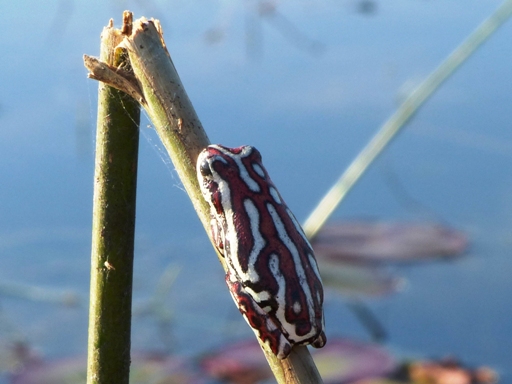
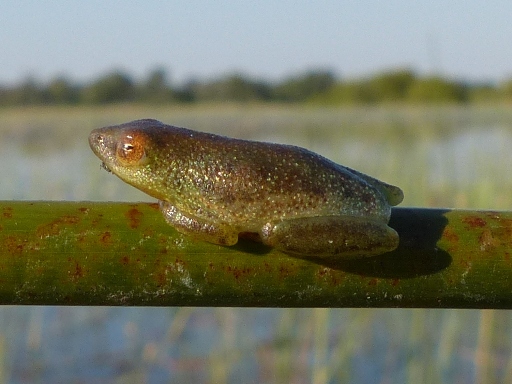
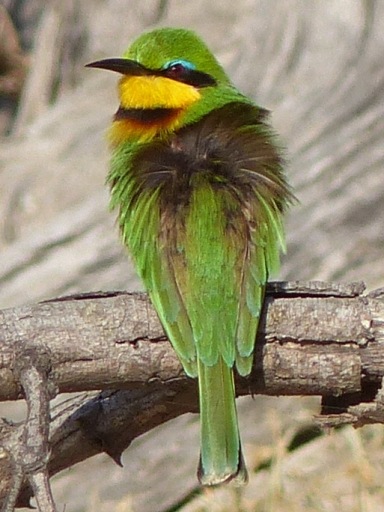

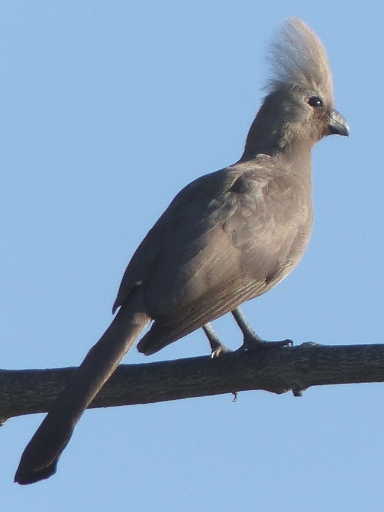
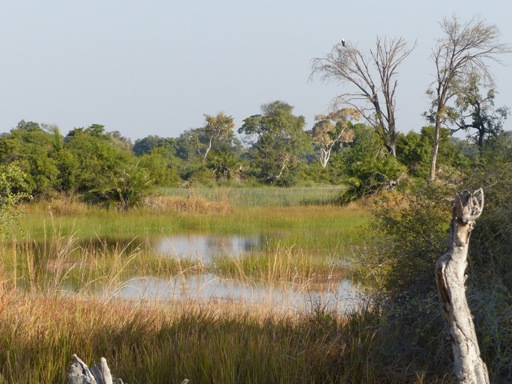
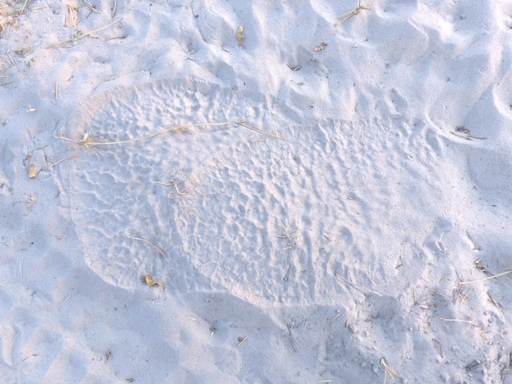
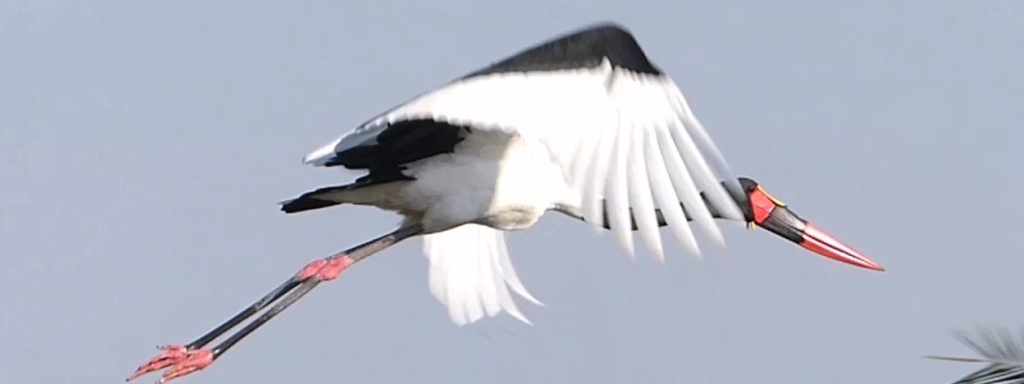
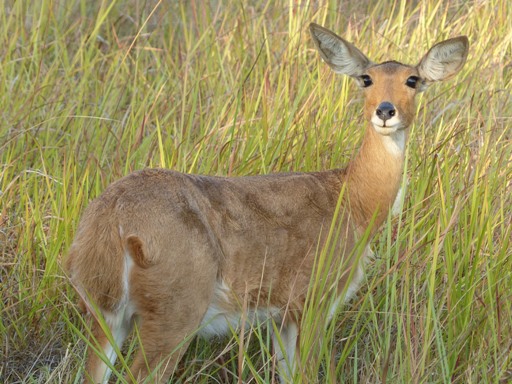

The Day 13 video is 2 scenes taken from the makoro: a sattlebilled stork taking flight; a pair of wattled cranes doing a small courtship dance then taking flight (spot the elephant?) (1:20)
Day 14
This afternoon we leave Pom Pom. Luckily our flight is scheduled for 1:10pm so we have time for one final game drive. It is just L.T., Cliff and me, so it provides a good chance to dig more into L.T.'s knowledge and wealth of stories. He suggests that it is about time for the zebra to start arriving, and then 30 minutes later we spot 2 groups heading for water. We claim that he must have spotted them before bringing up the topic, but he denies it.
14 of the 16 guests are flying out today as new travelers arrive, so we bid farewell to our new friends and set our sights on the next adventure.
The flight to Deception Valley Lodge on the edge of the Central Kalahari Game Reserve lasts 50 minutes and crosses much the same terrain as Kasane to Pom Pom, only in reverse order.
Jaco (say yak-o), our guide and manager greets us at the airstrip where the first order of business is to chase 3 ostrich off the runway so the plane can take off. Funny to see these flightless birds running down the airstrip. Maybe they have been watching as the planes take off and think that if they run fast enough they can do the same? They try, but fail.
Fifteen minutes later we arrive at the large and comfortable Lodge and discover that we are the only guests for both nights of our two night stay. Excellent.
The afternoon game drive is an exploration and education about the Kalahari and the history of the Lodge. I could fill pages with interesting stuff. One interesting fact is that the Kalahari is covered by fine white sand 100 meters deep. This means that there are no stones to be found anywhere, making life even tougher for the original bushmen. While not a true desert, it is very dry with no permanent natural water sources. Still, we see lots of game on the drive, at least in part because the Lodge and others pump water up from 100 meters down to create artificial waterholes. The kudu, gemsbok, steenbok, goshawk, jackal and white faced owl all make an appearance, but that doesn't really begin to describe the experience and interaction with Jaco and our tracker, Chota.
Dinner is served at a table for 2, outside by the fire and giant candelabras. Nishka, the chef, provides three delectable courses. They have gone out of their way to provide us a special meal. Another example of the excellent hospitality we have received everywhere in Botswana.
All this and free wifi too!
Ostrich on the runway; our transport; kudu skull and horn spiral; pale chanting goshawk; kudu females at the waterhole; steenbok; white faced owl
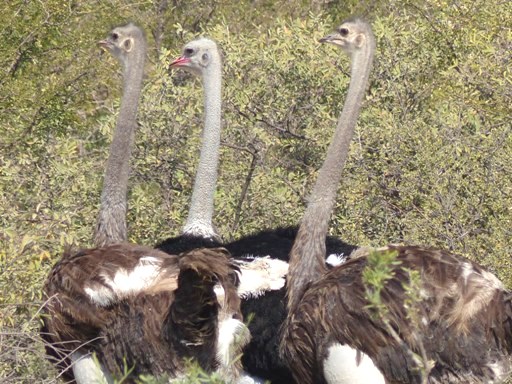
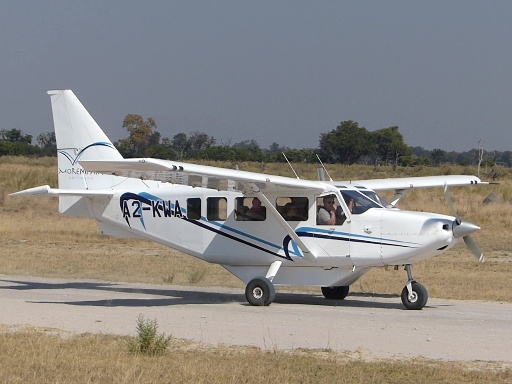

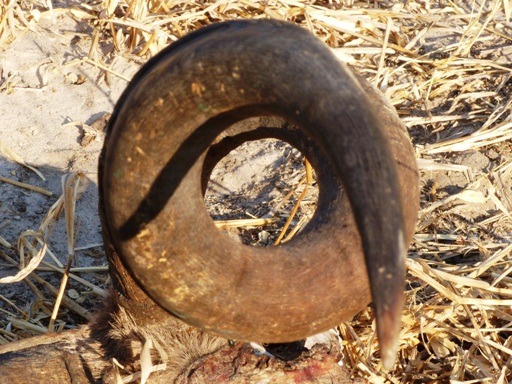
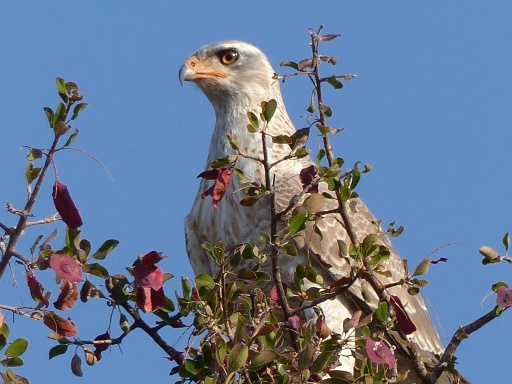
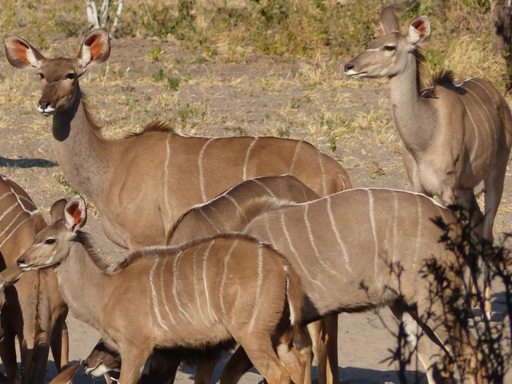
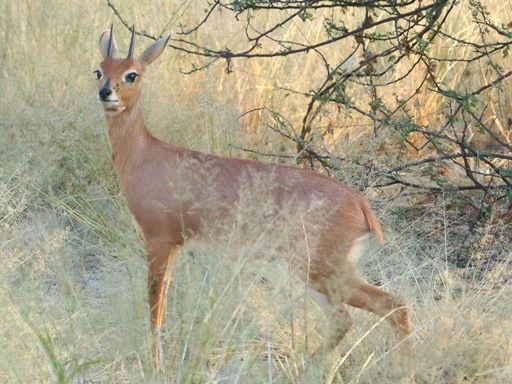
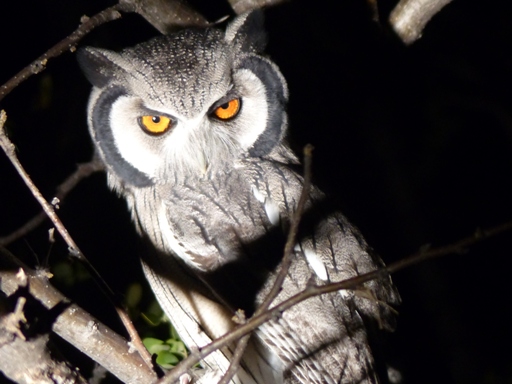
The Day 14 video is for aviation buffs as it shows our plane landing at Pom Pom then our takeof and landing taken form the plane. The landing clip gives a good view of the terrain in the Kalahari (2:16)
Jaco's first question in the morning is "Did you hear the lion roar last night?". I didn't, Cliff might have. So, again, we are on the hunt for big cats on the game drive. And we find him! Once again the tracker does a great job, literally tracking him from the Lodge and then spotting him, hidden by the bushes, about 50 meters from the road. We spend the next while visiting with the dominant male lion in the area. He is 10 year old, 380kg/850lbs, and a bit tired after long overnight walk. Two younger males are after his territory, and his days could be numbered. So perhaps his yawns to display those fearsome teeth are well earned. Jaco tells us that he feels a bit bad for bothering him, but he figures that the lion is just paying his rent for the kudu attracted to the pumped waterholes. Finally we tear ourselves away to continue the tour. Wow.
The rest of the game drive pales in comparison, but is full of variety and beauty. There is no such thing as a boring game drive.
This afternoon's activity is one of the reasons we came to the Kalahari - a walk with the San bushmen. No real bushmen still exist, or, at least, no one still lives the hunter/gatherer life that the original bushmen lived. But Chota, our tracker, and his cousin, Tom, are only one generation removed and have been trained by their grandfathers, fathers, and uncles in the old ways. They don the traditional attire, gather the traditional tools and weapons, and spend the next couple hours showing us how people survived in the past. Activities include fire making, ostrich egg water caches, killing game with poison arrows, spears and snares, and much more. They have obvious pride in their knowledge and heritage, and in sharing it with us. Hard to describe, you just had to be there.
Nishka again provides a delicious meal - a nicely spiced hummus with flatbread for starter, eland goulash on cous cous with tempora snow peas for the main, and a sweet syrupy cake/pudding with custard for dessert. Yum.
The sliver moon at sunrise; a kori bustard (the world''s heaviest flying bird); the lion and yawn; sand grouse; Tom and Chota
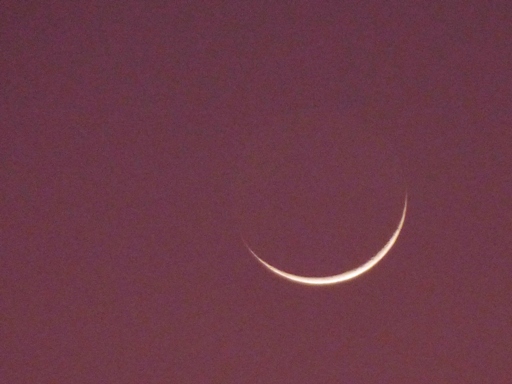

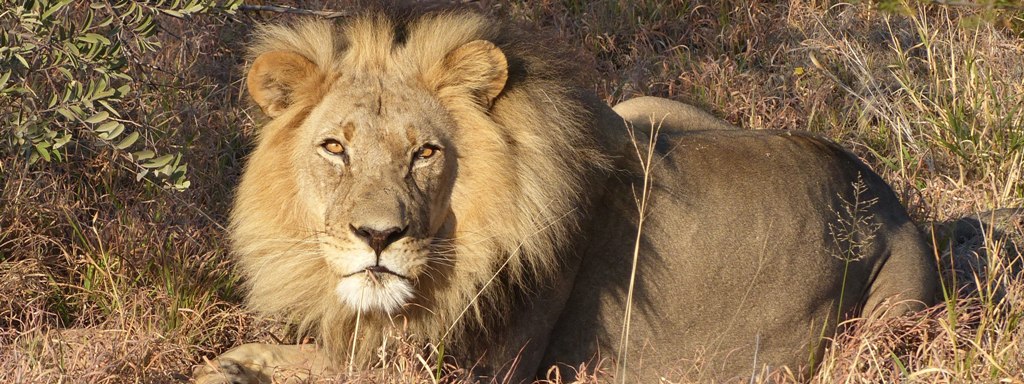
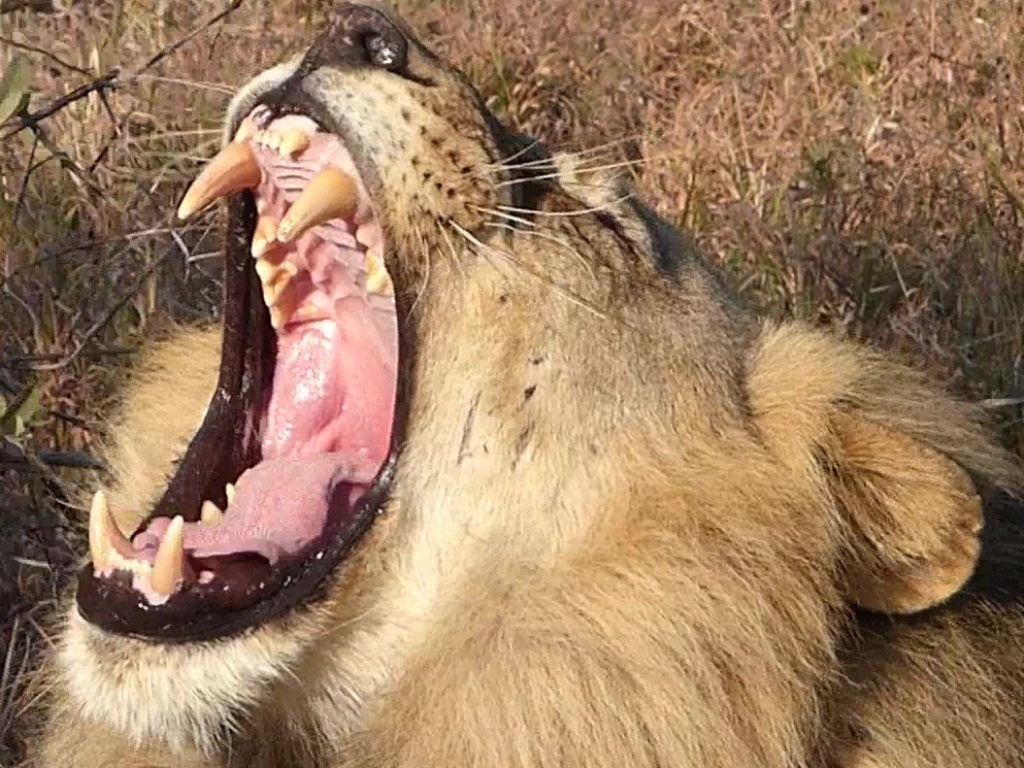
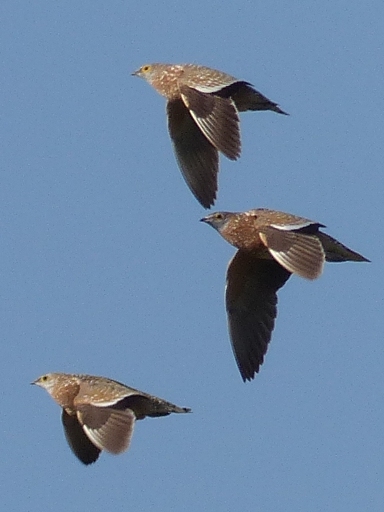
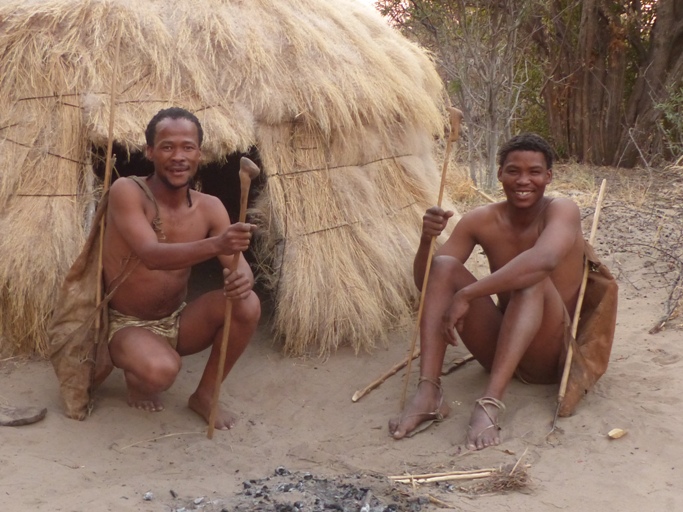
The Day15 video is scenes with the lion - including a nice description of the lion paying rent - and a dance that Tom and Chota did for us around the fire that they had lit by rubbing sticks together (4:38)
Day 16
Day 16 is the halfway point both in time and in style, and a travel day. Up until now we have been traveling by transfers and staying in safari lodges. From today we will be self-driving and staying in a variety of B&B and similar accommodation.
Halfway through I can report that the trip has exceeded all expectations. While it has passed quickly, it has been full of memorable experiences. Onward.
We bid farewell to the fine folk at DVL and take our last small plane flight to Maun airport, where the large fleet of small charter aircraft shares tarmac space with the newly purchased jet fighters of the Botswana Air Force. Jaco told us that the government had recently spent trillions of Pula on these planes, which he considered to be a bad deal. It does seem a strange choice for a country in Botswana's position.
The Air Namibia flight takes us east to Vic Falls first before taking us west to Windhoek (say wind-hook). We take off 15 minutes early, but that is eaten up in the shambles of disembarkation, transit, and boarding in Vic Falls.
The rest of the trip goes smoothly, we pick up the car, find the B&B, ask lots of questions, do the shopping, go out for Chinese food, and are ready for the road trip to begin.
The boarding gate and emergency department at Deception Valley (CB)
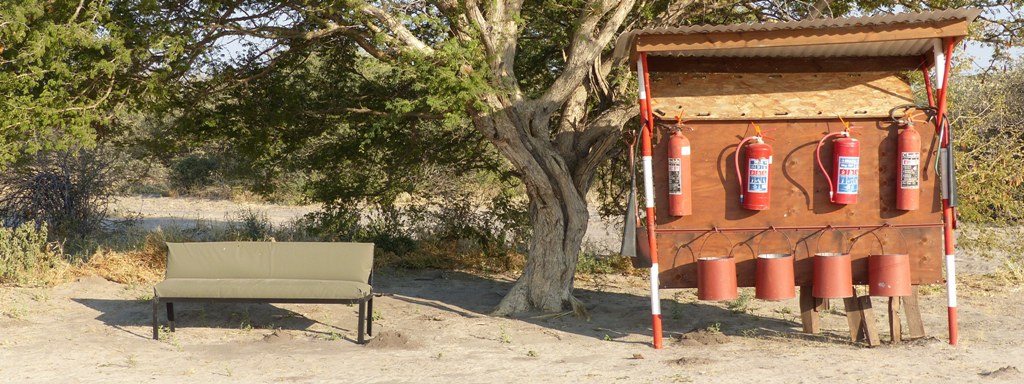
Day 17
We get a slight sleep-in and are on the road at 8:15am. The drive from Windhoek to Sossusvlei (say so-sus-flay) takes 6 and 1/2 hours with plenty of stops. It is primarily on gravel roads. They are all in good condition, varying from perfectly adequate to really excellent. The terrain is rugged and mountainous, rising up to 1700m/5600ft at the highest point. We compare some of the scenery to the California desert, and some of the rock outcrops to outback Australia, but the plants and animals are all Africa. One notable feature are the many sociable weaver nets in the trees along the road. Some are huge, the size of a small elephant, and house a big colony of birds. Unfortunately all are deserted, not sure where the weavers have flown.
Our rental car performs well, and we have no trouble. In fact, our only brush with disaster is when I nearly run over Cliff in the B&B parking lot.
The BBQ at the Sossusvlei Lodge features 9 different kinds of game meat. I try 3, including oryx and zebra. All are good, and not especially gamely, probably because they have been farm raised.
We retire wishing for light winds in the morning as we plan to take a ballon flight if the winds allow it.
Terrain along the drive with a warning to stay on the road and a quiver tree (kokerboom) (CB); our tent cabin and the doors to a sociable weaver nest
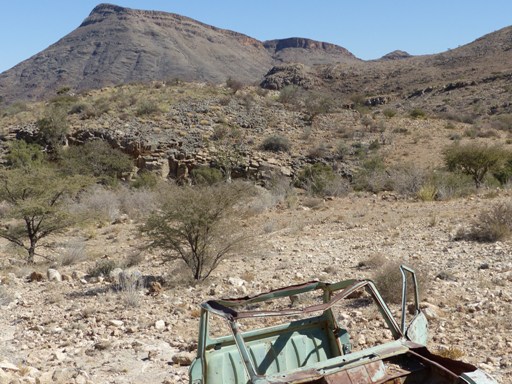
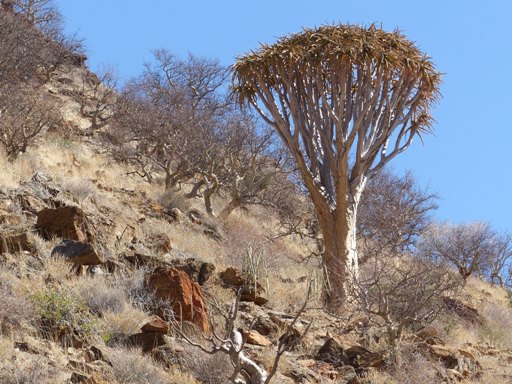
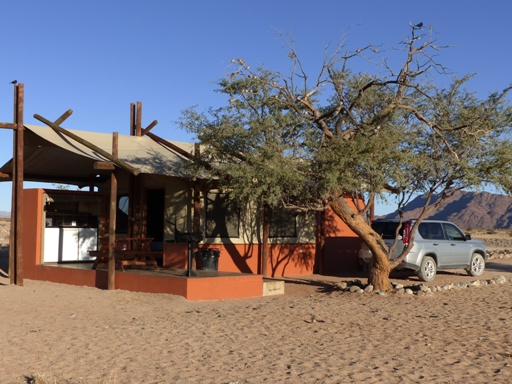
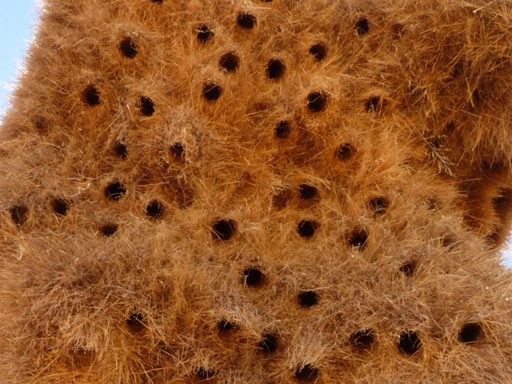
Day 18
Day 18 begins in the same fashion as many other days on this adventure: with a once in a lifetime experience.
A check of my cellphone at 5am shows that the ballon flight is on, so at 6:30am we are standing in a small crowd of excited would-be fliers watching 2 hot air balloons inflate. Though, given that the temperature on the ground is below freezing, perhaps they are only warm air balloons.
We climb into the basket, ascend gently and travel along the valley between the mountains and the dunes. The morning is absolutely perfect, light winds, stunning light on the dunes, a fun atmosphere in the basket, and a champagne breakfast when we land. Stupendous.
We spend the rest of the day exploring along the valley and among the dunes. I have learned in past visits that sand dunes are one of those subjects that always demands another photograph - and that doesn't change for this visit. Was the light like this for the last shot? I'm sure it looks different now. Look at the shape of that sinuous ridge from this angle. And so it goes. Plenty of photo editing and sorting will be required later.
At the very head of the valley is an old dry lake bed - Deadvlei (say dead-flay). This white dry lake is at the very foot of the largest dune in the park. When it was wet trees grew there. The water is long gone, as the lake has been dry for hundreds of years. The skeletons of the trees stand in stark contrast to the white lake and the orange dunes. The shapes and colors are eerie, and the whole place has a haunted feeling. Not scary, beautiful but somehow disturbing.
On the drive home we try to capture an Oryx photo such that the two horns overlap and look like one - giving a quasi-unicorn look. We succeed to some extent, and might have done better without the distractions of the ostrich and the shifting shadows and colors of those shifting sands. What a day.
Balloons filling at dawn; looking up from the basket; dunes seen from balloon; looking up valley from the basket; more dunes; oryx shadow (pity about the focus); ballon landing for champagne breakfast; more dunes; oryx; deadvlei; Big Mama dune; pied crow; deadvlei; more dunes; sand rippled by the wind; oryx as unicorn
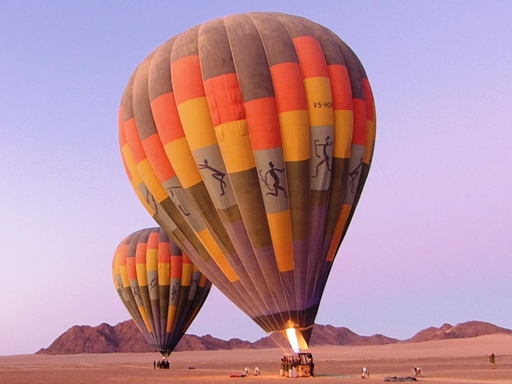

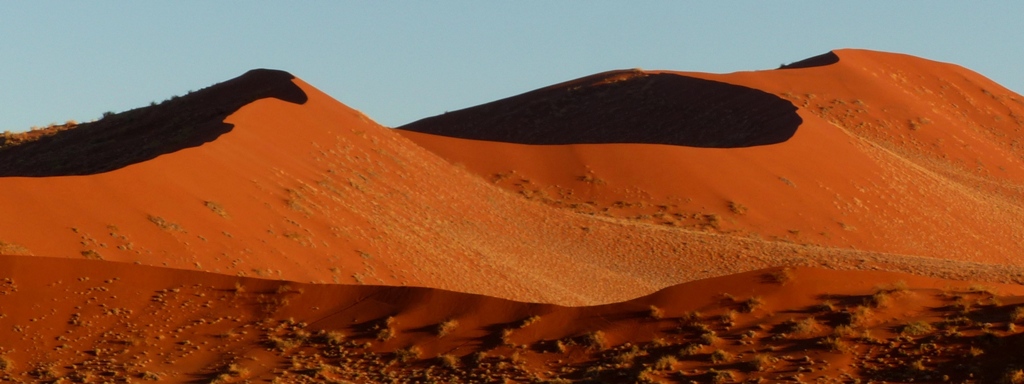
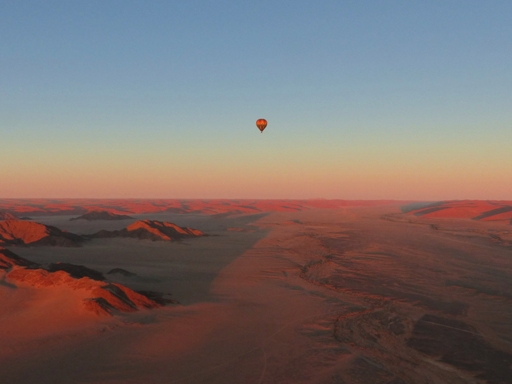
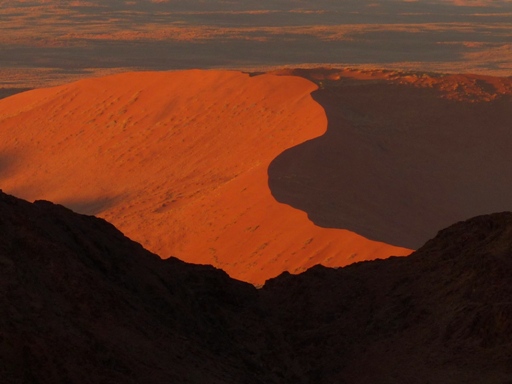
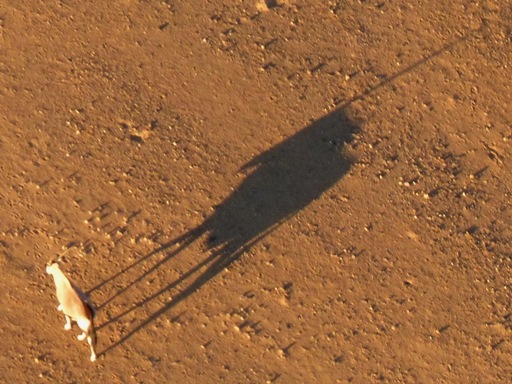
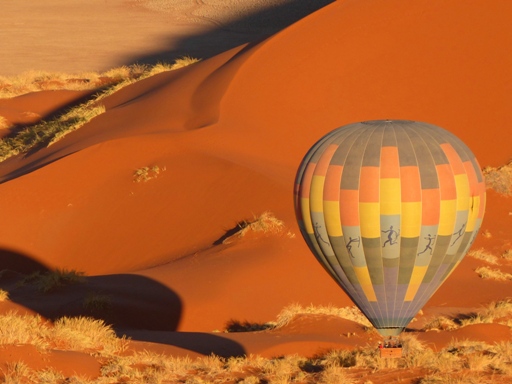
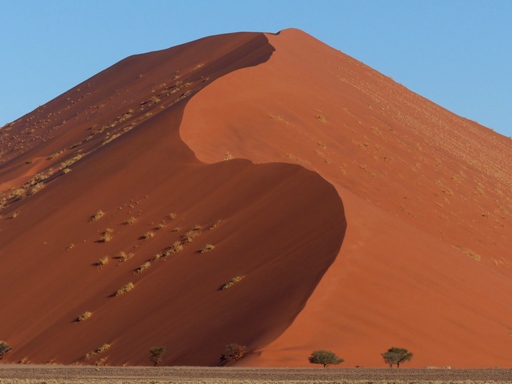
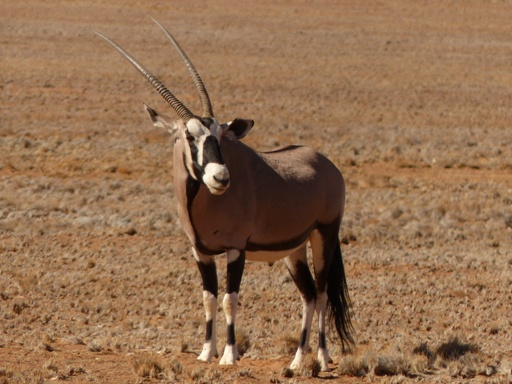
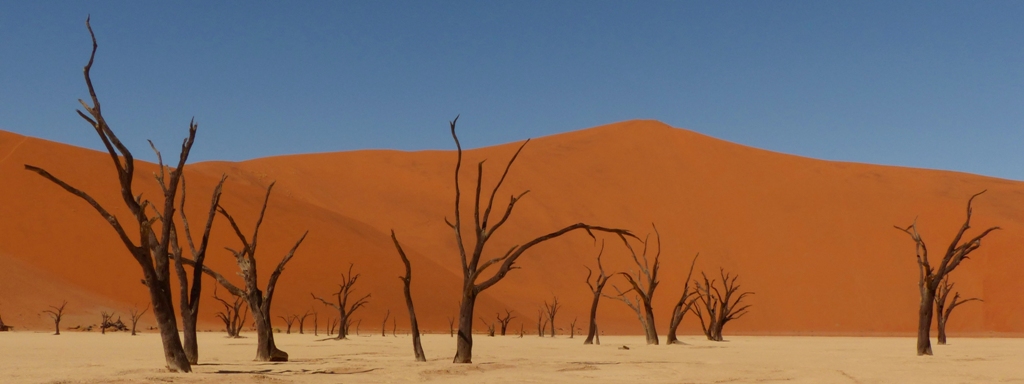
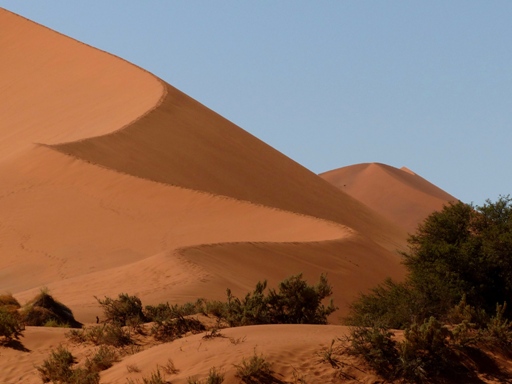
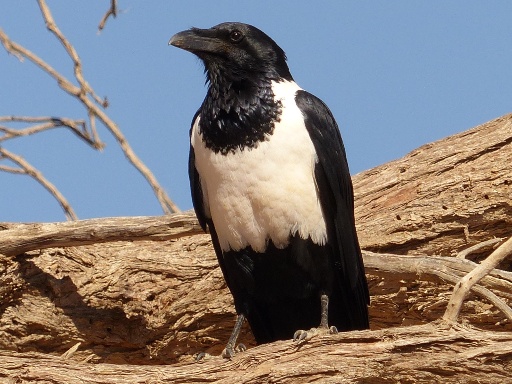
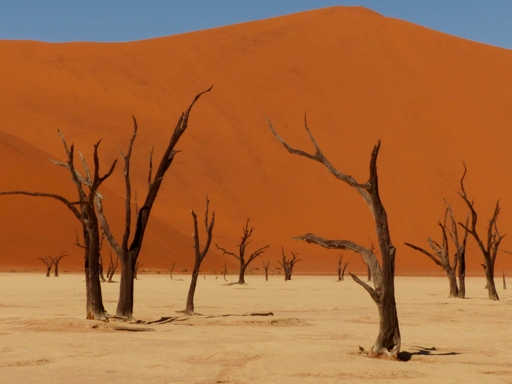
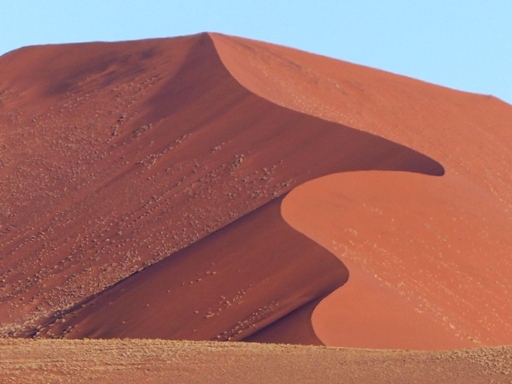
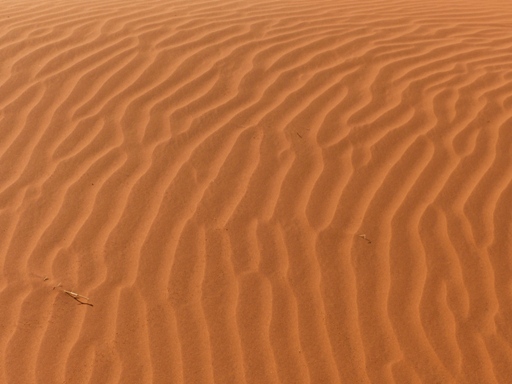

The Day 18 video is scenes from the balloon flight and a not very successfull attempt to track a colorful beetle across the sand (2:51)
Day 19
Day 19 is a travel day. We depart early to cross a part of the Namib desert on the way to Walvis Bay and Swakopmund. Again our X Trail vehicle performs well and the roads are good. The last stretch is a dirt superhighway. The terrain is always bleak - sometimes rugged rocky bleak and sometimes flat empty bleak.
We stop for a picnic at Dune 7 in Walvis Bay. (It seems like dunes are numbered and not named. Not sure why. Perhaps because of their ephemeral nature?). It is a Saturday afternoon and the locals are at play in the picnic ground. Modern African music pumps out of the neighboring site, while crowds of locals struggle to ascend the dunes, only to turn after a short rest at the top and walk back down. Normally I like to climb to the highest point around for a bit of fun and a view, but the dunes are not even a little bit tempting.
Then off to the lagoon to admire the flocks of flamingoes and on to Swakopmund to catch up on logistics. We were worried that things might be closed on Sunday, and learn that on this particular Sunday the entire city will be without power from 6am until 6pm. So, we rush around to complete our chores before an excellent seafood dinner at The Tug.
On the road; quiver tree (CB); locals picnic at dune 7; greater flamingoes; lesser flamingoes

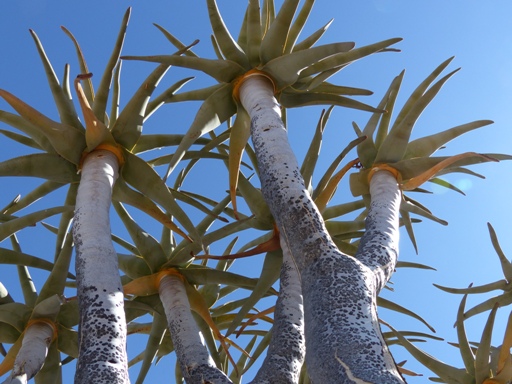
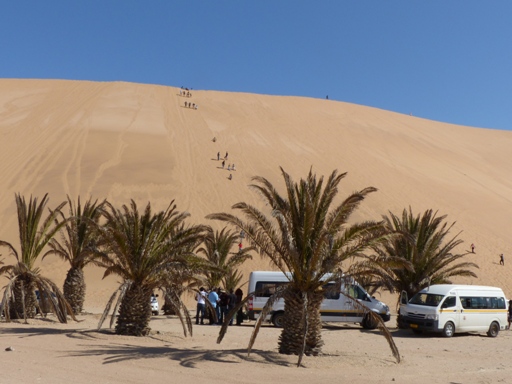

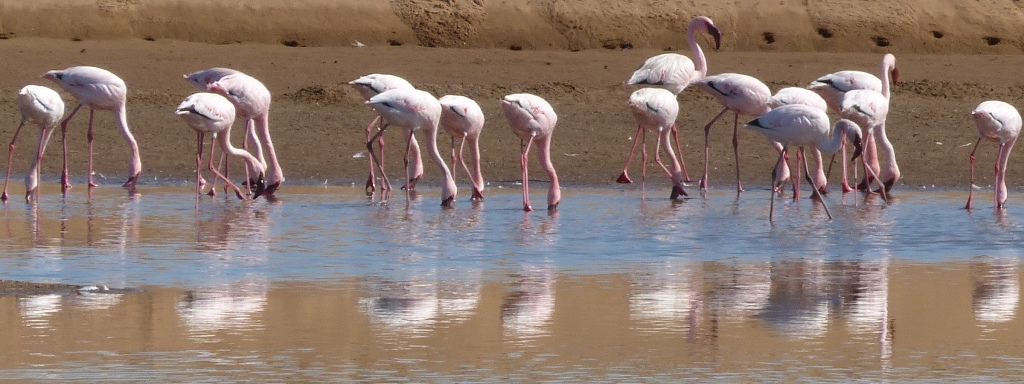
The Day 19 video features a clip of an ostrich in the bleak terrain (CB) and scenes of the flamingoes in Walvis Bay (1:52)
Day 20
Day 20 starts in a fog. Swakop (as the locals call it) gets very little rainfall - about 40mm or 1.5 inches per year on average. But, we used the windscreen wipers all morning. A thick fog or thin mist rolls in from the ocean and keeps us cool and damp all the way to the huge fur seal colony at Cape Cross. This moisture supports some life in the coastal strip, but not much. The seals are great fun to watch, with the 6 month old pups just becoming independent, if not so much fun to smell. Also at this point is a replica of the stone cross erected by a Portuguese navigator as he came down this coast in 1487. The seals were there then too.
The drive to Twyfelfontein takes the rest of the day. Roads in Namibia are graded. Until now we have been on B roads (paved), and C roads (smooth dirt). Today is our first extended time on D roads. Some sections are very badly corrugated/washboarded. An hour passes with only occasional 15 or 20 second longs gaps in the shuddering. When no oncoming traffic is in sight, which is almost all the time, I am free to weave from the far left to the far right of the road in search of a smoother track. It doesn't help much, but at least it keeps the driver busy.
I note that there are no A roads. Perhaps the Namibians recognize that even their best roads are only worthy of a B grade? Or perhaps they have the foresight to save A grade for the superhighways of the future?
English is odd. If the road grading machine gives the road a better grade, then it will be graded better by the road grading engineer for the map too!
Twyfelfontein Country Lodge is large and impressive, with the units scattered some distance from the main lodge. We are in unit 1 of 56 and thus have the shortest walk to dinner.
Seal pup; Seal with a handy rock pillow; it is a big seal colony; road mirage; a faux postcard extolling the scenic virutes of a Namibian rest stop
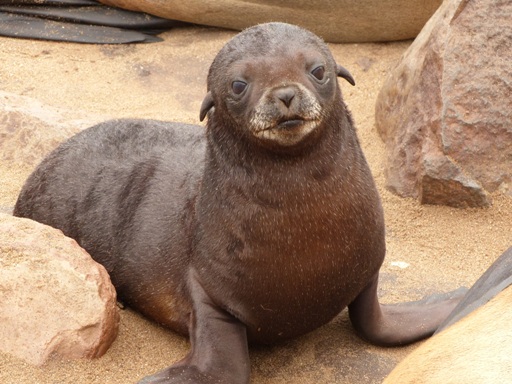
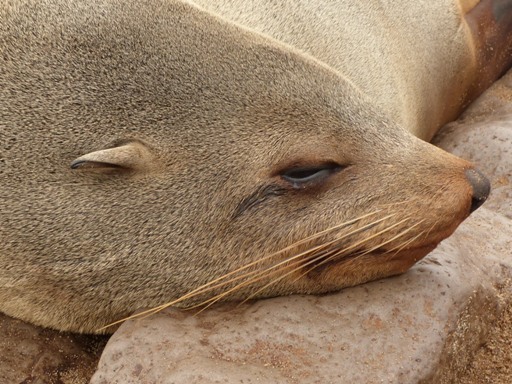
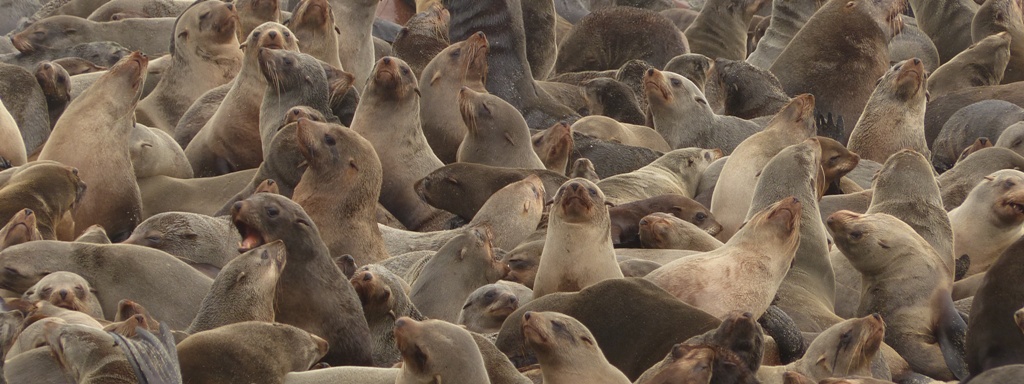
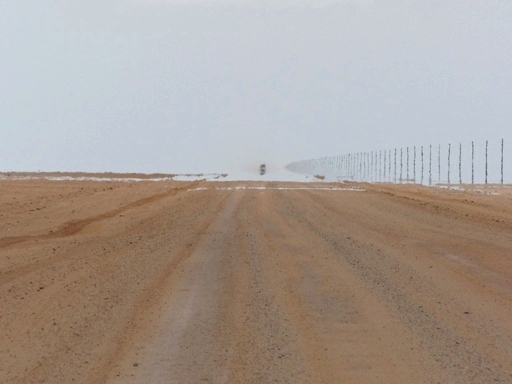
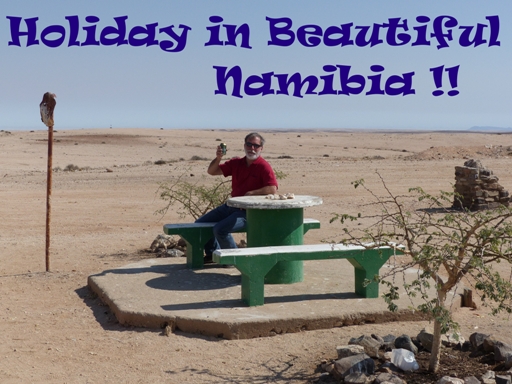
The Day 20 video is scenes from the seal colony. Be glad it isn't smell-o-vision (2:51)
Day 21
Unit 1 also has the shortest walk to breakfast, and turns out to have other advantages as the day unfolds.
One of our instructions to Sian, our travel agent, was that, where possible, we preferred not to travel every day, and to spend 2- 4 nights in one place. Thus, we have 2 nights in Twyfelfontein, a relatively isolated and quiet spot. The main reasons people come here are for the prehistoric rock art, and the desert elephants.
We spend the morning touring the rock art sites. Our guide, Charmaine, is excellent - informative, interesting, and willing to accommodate our pace and style. The art itself dates back to the times when the nomadic San bushmen had camps in the rocks and caves of the area It is 6000 to 2000 years old, and tells various stories. We call briefly by the Organ Pipes, a small area of basaltic columns. The columns themselves are also small, smaller than others I have seen elsewhere - a few inches in diameter. They happen to be nicely lit by the late afternoon sun and we play around making a bit of art of our own with our cameras.
We are home for lunch, and decide to forego the 3pm game drive which goes out to try to see the elephants. This afternoon is our first real down time of the trip, and the spectacular setting of the Lodge makes it a good place to kick back.
I have been backing up photos to my iPad, in case disaster should strike the camera or the memory card. Unfortunately, the iPad is now full - and after only 1200 photos and videos! I can remember trips with a film camera during which I averaged 6 photos per day. Now, in burst mode I can take that many in a second. So, I spend some time reviewing the contents of the iPad, and deleting some of the less worthy ones to make space.
Just at 3pm, as the game drive is headed out, one of the staff comes to our door to let us know that the elephants are coming up the drive! Sure enough, a herd of 16 has come to drink and feed in front of the Lodge. We do a quick game drive of our own, but can see that the veranda of unit 1 is actually the best place to be. So, back we go to sit on our veranda and watch them feed in the streambed right in front of us. An hour later they are gone. You just never know what to expect.
So, back to photo sorting and a sundowner before dinner.
But, later, it occurs to me that we are not in a national park or game reserve. These elephants are just roaming round the countryside. We had earlier seen elephant droppings and damaged trees on the path to the rock art. There are local villages nearby. When I ask a local what they do when a herd of elephants arrives at a village, she says that they call for government assistance. I imagine that if a herd of elephants made its way up the Otahuna valley I would be reaching for the phone and not the camera - but try calling 111 or 911 and telling them the elephants are at the door! They are a serious menace, wrecking havoc on gardens and even taking the occasional life.
Two rock engravings - with many animals plus the lion man (note the human hands) and the dancing kudu; rock painting; a detail of the painting; the landscape where the art is found; organ pipes; the ad-hoc game drive (note Unit 1 can be seen between the elephants); the elephant that approached Unit 1
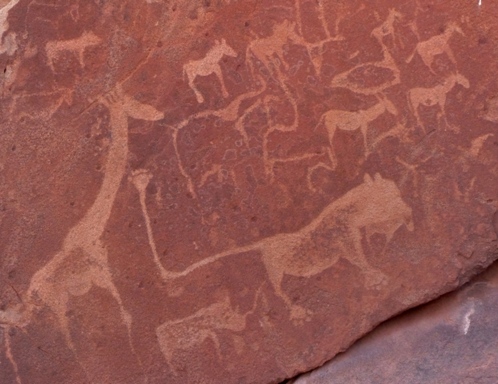
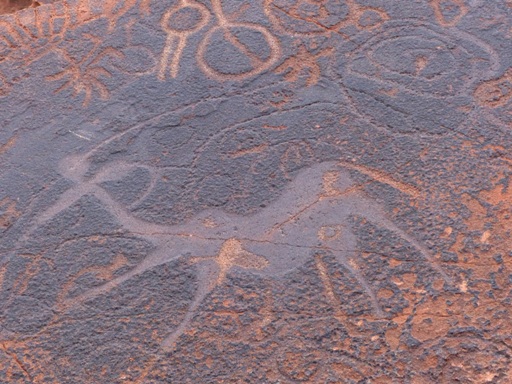
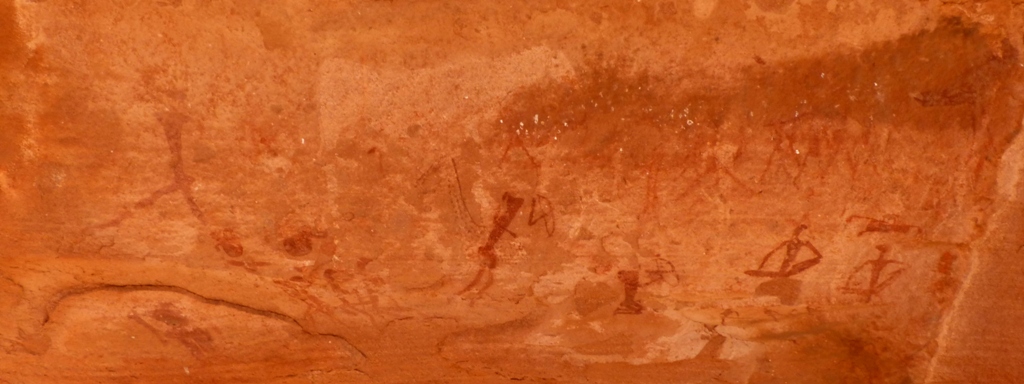
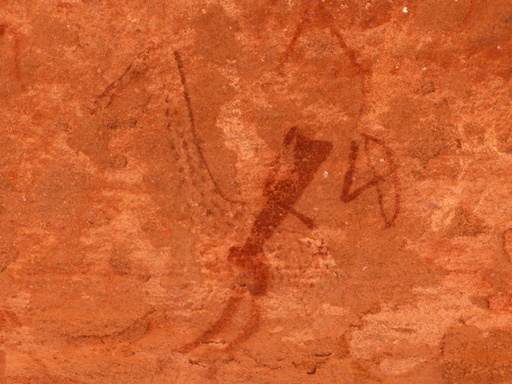
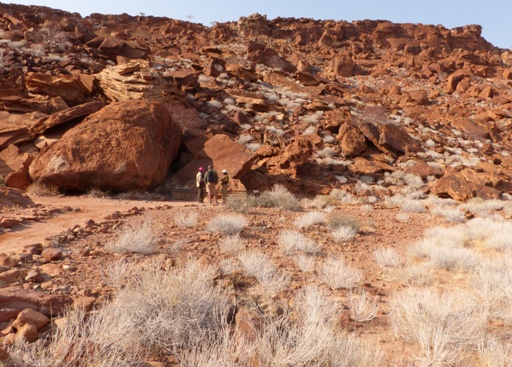
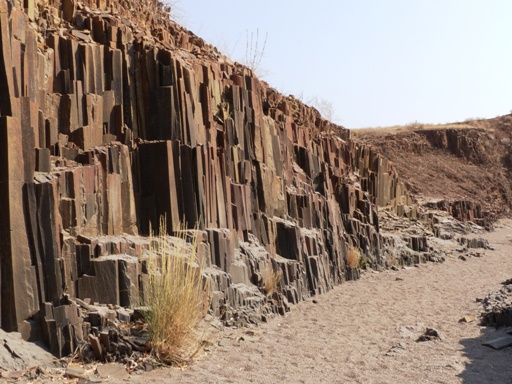
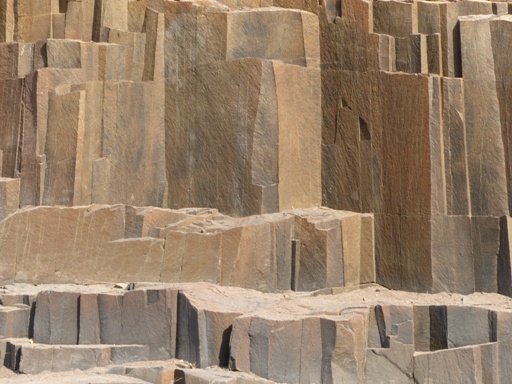
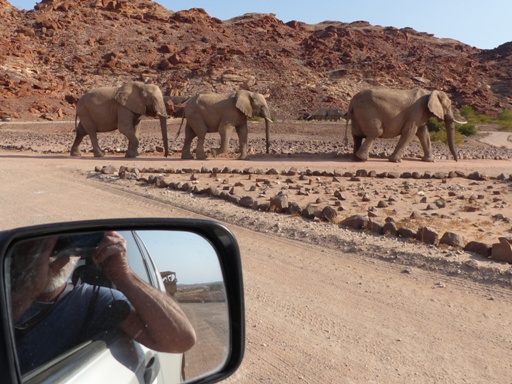
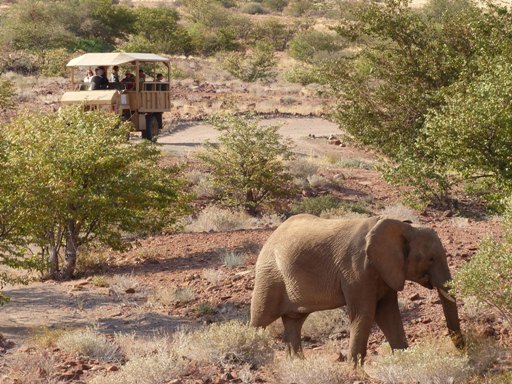
The Day21 video was filmed from the Unit 1 veranda as the elephants arrive and then one comes quite close. (1:41)
Day 22
Day 22 also starts in a fog, as the moist air from the coast has been carried on the wind 100 kilometers / 60 miles inland. We stop at the underwhelming petrified forest, with almost equally underwhelming welwitschia plants. Soon afterward we hit the pavement (a pleasant surprise as we are on C roads) and cruise all the way to Okaukuejo Camp (say Oh-cow-kway-yo).
We have included this stop for several reasons, including the fact that it holds fond memories for Cliff. He spent a few days camping here 20 years ago, and remembers it as "the best game viewing he has ever had". It seem like the animals are glad to see him back because as soon as we pass through the park entrance gate we encounter a herd making their own "zebra crossing" of the road.
Etosha is a huge pan (dry lake bed) with a small number of waterholes scattered around the edge. The animals converge on the waterholes in good numbers and great variety, and we have ringside seats. The waterhole at Okaukuejo is floodlit at night, and our chalet is about 50 meters from the edge.
We unpack and settle in. The oryx and springbok are drinking and a big herd of giraffe are on the way. Just as they get close, the solitary male lion that we had spotted in the shade gets up and ambles toward the water. he lies down near the edge, and nobody gets a drink. The poor giraffe, you can see them cautiously looking for a safe way to drink, but there is none.
After some time the lion gets fed up with the pestering jackals (or so it seems) takes a leisurely drink, and walks slowly off stage.
It does seem a bit like theatre. You sit in your seat and watch the actors enter and exit. I take breaks from writing this as the zebra, oryx and elephant come and go. The springbok and birds are always there.
Cliff gets up several times during the night. At the 1:30am visit it is just the black rhino and him. The floodlights allow you to see, but are intentionally dim to avoid blinding the animals. Photography is difficult, requiring long exposures and manual focusing. Still, Cliff manages to make it work. He is helped by the fact that many of the animals stop and remain virtually motionless at times. Almost like they are posing, but I suppose they are just listening and smelling to sense what is out there. One thing I have observed over and over again on this trip is that wild animals are very, very patient.
More elephants are on the way now.
Petrified log; welwitschia in bloom; zebra crossing; sociable weaver working hard; giraffes and an oryx keeping a close eye on the lion (and one of my favorites); lion and jackals; black rhino; black rhino closeup (CB) (note the prehensile lip for browsing)
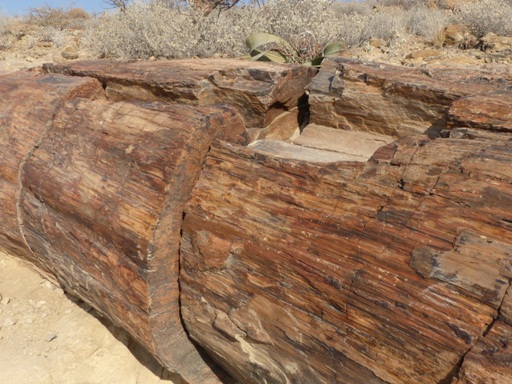
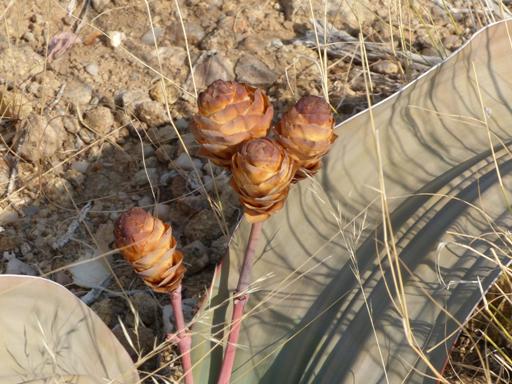
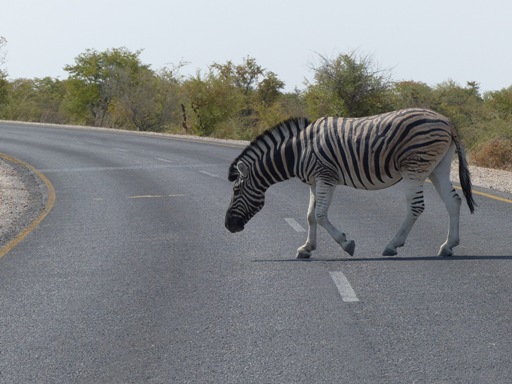
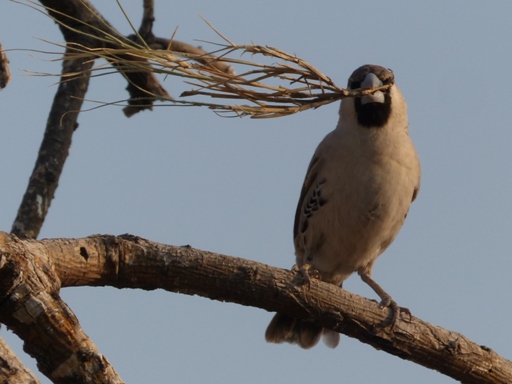

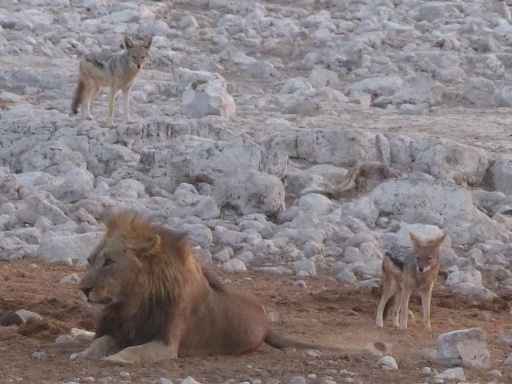

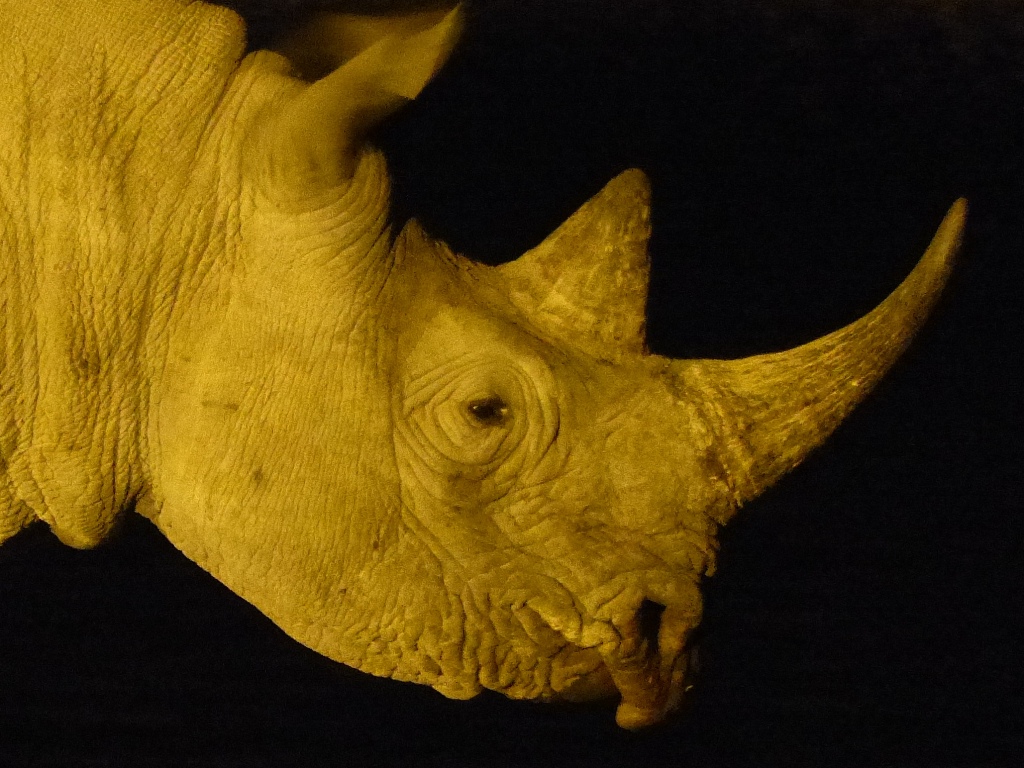
The Day 22 video is two short clips of the giraffe spotting the lion at the waterhole (0:49)
Day 23 is my birthday! Will you still love me when I am 64? I hope so.
Sweet 16 times 4; 8 squared; 40 in hexidecimal; and my last power of two birthday (2x2x2x2x2x2), which is significant for we digital types. And here is a scary thought: a person celebrating their 64th birthday in the year of my birth was born in 1887. Which means I am about as culturally similar to a person born this year as I am to a person born in 1887. Not sure which is worse.
But the routine doesn't change - after a check of our waterhole and breakfast we set out for a game drive to other nearby waterholes. I'd give the roads a C-minus.
The day is filled with various encounters on the road, and more theatre at our waterhole. Cliff buys me a bottle of wine which we share (thank you Cliff) and my birthday passes without cakes, candles or singing - just the way I like it. Sorry Jill.
Except maybe the lions wanted to wish me happy birthday as we hear many roars, quite close by, through the evening.
Jackal; ostrich; zebra; elephant; giraffe; oryx - all at the waterhole except ostrich
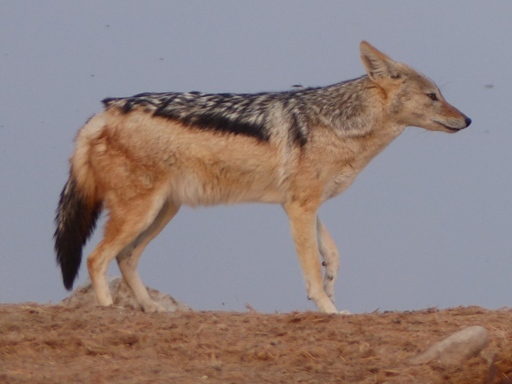
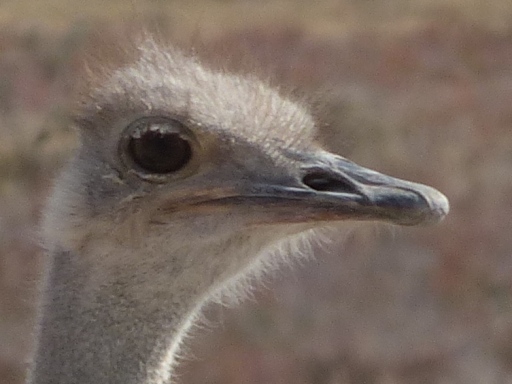
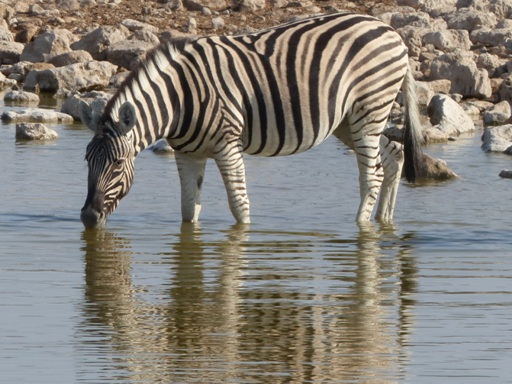
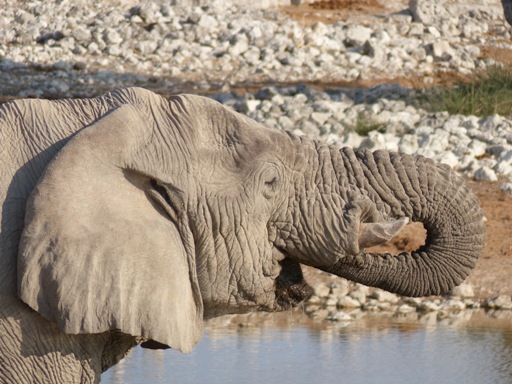

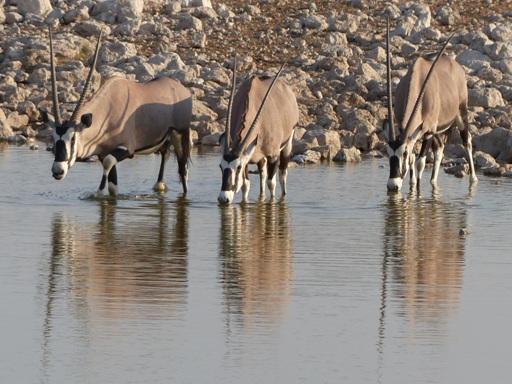
The Day 23 video is a long one (6:00) and mostly features scenes around the water hole with jackals playing like puppies; a long sequence of elephants arriving and exchanging greetings; giraffes drinking; plus and a short clip of ostriches.
Day 24
On Day 24 there are clouds, actual clouds, in the sky all day long. This is a first since Umkumbe.
We pack a lunch with the expectation of spending the whole day in the park, thus allowing a good amount of time for waiting and watching. Within a few kilometers we find 3 lions - 2 males and a lioness. They are probably the same ones we heard roaring yesterday evening. They are dozing not far from the road. We sit and watch, with the only activity being the occasional pursuit of the lioness by one of the males and their mating. For long stretches they just lie around. I am intrigued and amused to notice that they often sleep on their backs with their legs in the air, just like our house cat, Bonnie. Who knew that she was channeling her inner lion.
The rare bursts of activity are mating attempts, which involve a bit of pursuit as she is fairly obviously annoyed. Still, his persistence pays off.
One funny moment is hard to describe, but I'll try. Between the cars on the road and the lions on the grass there were always various ground birds feeding. They were almost entirely silent until just at the moment of mating when one of them took to the air and gave a long cackling call that sounded very much like laughter. The timing was uncanny, watch the video to see what I mean. It was very funny.
When there is action, or even just when they are lying around, we are close enough to see just how big, strong and healthy they are - especially the lioness. Magnificent.
The day passes in similar activities with many stops for wildlife sightings. We see the usual giraffe, elephant, ostrich, and the rest as well as our largest herd of zebra yet, a black rhino, and first sightings of red hartebeest and a meerkat. We get to the gate just before it closes at sundown, and are thus in time for the sundowner at our waterhole.
Sleeping male lion that our housecat, Bonnie, often imitates; lion pair x 3; kudu buck; northern black kohraan
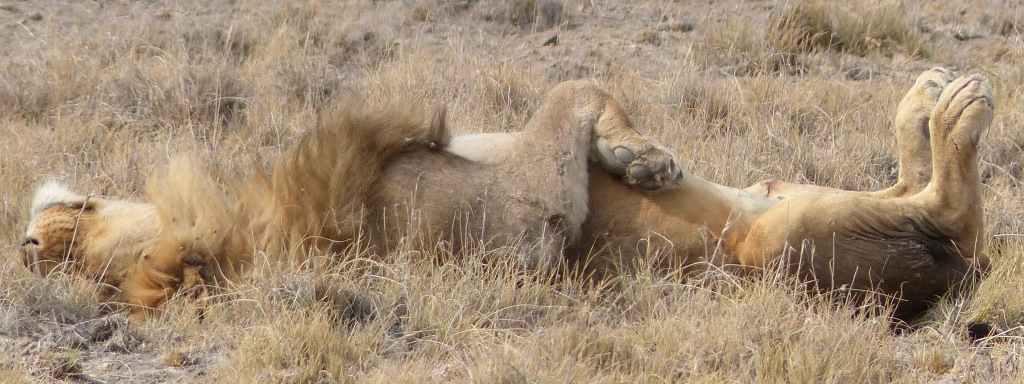
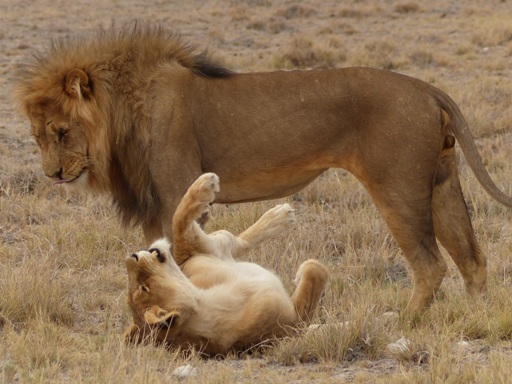
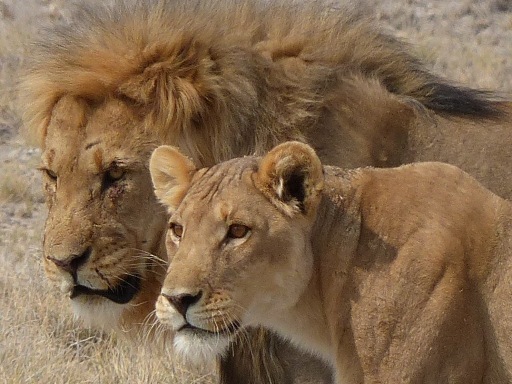
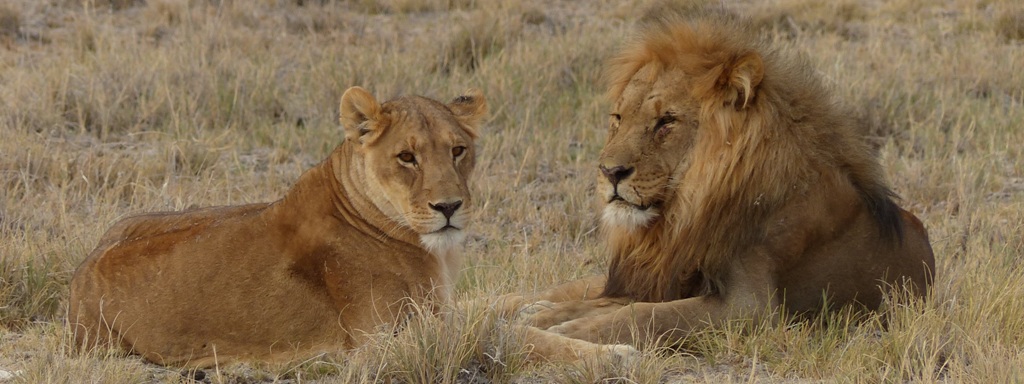

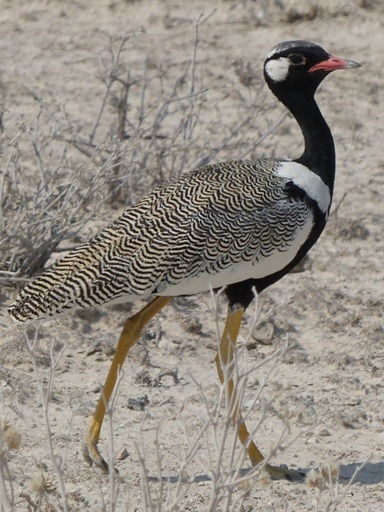
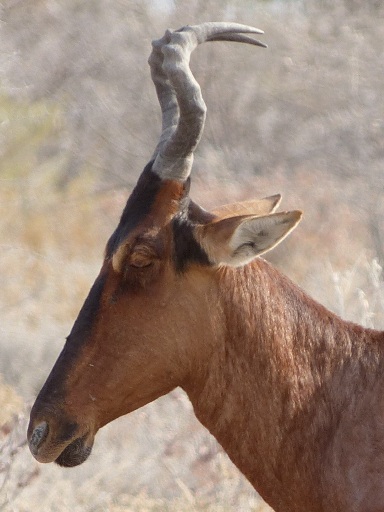
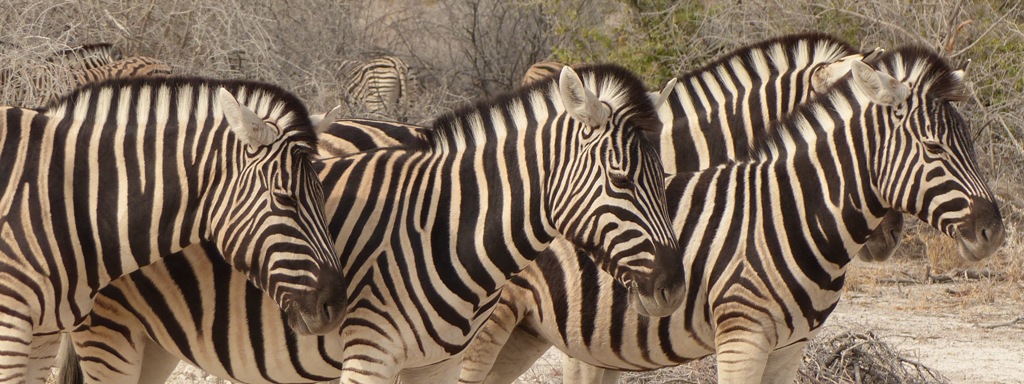
The Day 24 video is of the lions, including some lion porn and that cackling bird with the perfect timing (3:16)
Day 25
On Day 25 the sky is cloudless all day. It is the 3/4 mark of the trip, and also the end of the safari adventures as we return to civilization in Windhoek and Cape Town.
Our last morning in Okaukuejo is spent in the usual way, on game drive and visiting waterholes. The experiences are as enjoyable as ever. We drive to the very edge of the pan. It is huge (as big as Israel says the guidebook - does that help? Not to me.). The animals march in lines to reach the precious water.
Our last waterhole is just at the exit gate from the park. We pull in and find it overflowing with animals. Cliff has a thing about noting the number of different species of animal that can been seen in a single place or photo. He sets a new personal best with 7 species in this place - springbok, oryx, zebra, kudu, impala, wildebeest and ostrich - though only 5 can fit in the same photo. It is as if they have all come out to bid him farewell.
The rest of the day is the long drive back to Windkoek, on the pavement all the way. We arrive just at sunset and call into the Chinese restaurant King Dumpling, which is giving away a free beer with each dinner as a winter special. So, a sundowner and a nice meal all in the same package.
Wildebeest headed to water with the huge dry pan behind; wildebeest; springbok
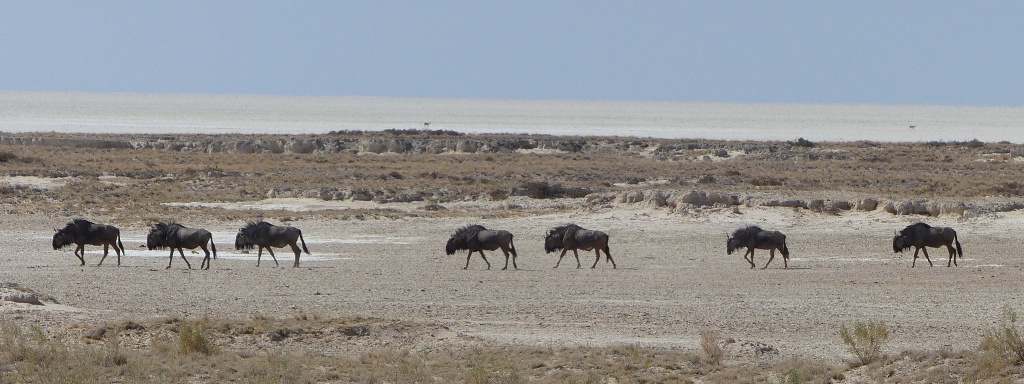
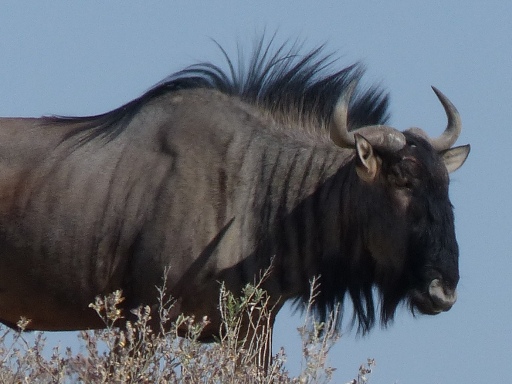

The Day 25 video is of springbok at the waterhole (0:44)
Day 26
Our flight to Cape Town is not until the afternoon, so we have a leisurely morning and then head to downtown Windhoek for a bit of shopping. The Bushman Art Gallery is a sort of combined museum of African art and a retail store. We wander through in slow circles. Cliff is tempted by many items, but resists most. I buy a t-shirt (whoop de doo). We fairly quickly lose interest in downtown and end up at the airport way early. I write Trip Advisor reviews. The flight takes off late, but once in Cape Town getting to our B&B in Stellenbosch is routine. On arrival I accept the host's generous offer of a welcome whisky, and we are shown to our room. It isn't really cold, but hot water bottles again warm the beds. Aren't we spoiled.
No photos from today! So here are a few taken during the trip playing around with the camera's monochrome setting. Dunes; organ pipes; a cat's eye view of a zebra's eye; giraffe at the waterhole

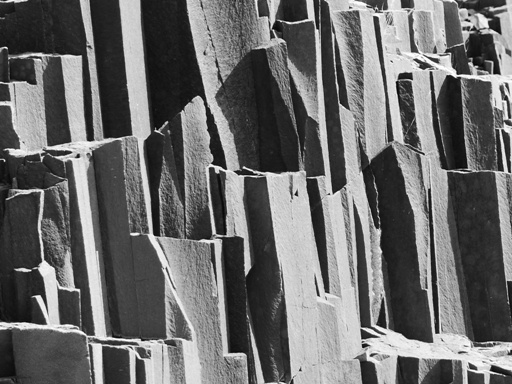
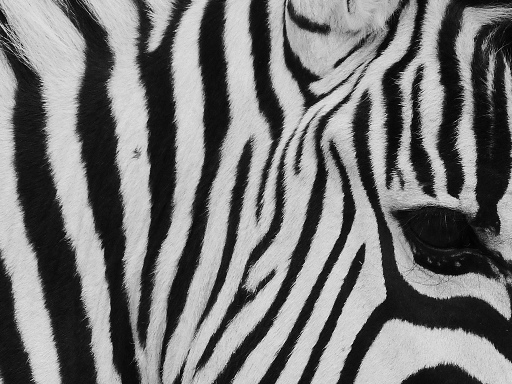
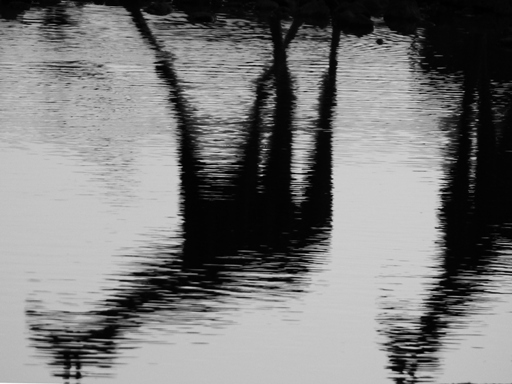
Day 27
We are picked up for our tour of the wine regions around Stellenbosch after breakfast. It turns out that Cliff and I are the only clients on a quiet Sunday. We visit 4 different estates and taste multiple wines at each. All (or at least almost all) are very good. The tour also includes a tasty lunch at a cafe. The area is ruggedly mountainous and very scenic, Some of the estates were founded in the 1600s by early Dutch settlers, so there is history here too. All in all a nice day out.
Back at Umkumbe, early in our trip, Cliff took an excellent photo of a zebra partially obscured by foliage. He was intrigued, so then captured several others of animals hidden in the bush. He liked them, so adopted this "Africa obscured" theme for his photos. Meanwhile, he has been emailing photos regularly to a large group of friends. With the wine tour coming up, he has been plotting what sort of photo to send them. Pink elephants? A scenic snapshot intentionally out of focus, and with the horizon tilted? It turns out that he needn't have worried. After our first wine estate stop, and tastes of 5 wines, Cliff walks out to take a few photos of the mountains and the vineyards. He snaps a few, but something is wrong. The images are all black. Oh no, is the camera broken? No, nothing like that, he has simply neglected to take off the lens cap! We laugh and then laugh some more! Africa obscured indeed!
Over lunch I try to engage our guide/driver in discussion on the current state of South Africa. He responds that he "would rather eat glass than talk politics", and that is that.
I am not a foodie. Far from it, more of a philistine really. But, somehow, food seems to have featured quite a lot in this account. Not sure why exactly, but why stop now? Dinner is at a recommended local restaurant, Oppie Dorp, just 10 minutes walk away. It is great. My starter is baked aubergine stuffed with cheese and mushroom and served with a tomato basil sauce. The main is slow roast gemsbok shank with mash and red wine gravy. Cliff has the smoked salmon starter with the ostrich medallions main. We both have a glass of wine. We are far too full to even look at the dessert menu. The bill, with tax and tip, comes to 275 Rand, $US 23, $NZ 34. Great value.
This seems a good place to include some of Cliff's "Africa obscured" photos. This theme started with the excellent zebra photo and continued and developed throughout the trip. All photos (CB).
Zebra; lion eyes; kudu; hyena; giraffe; elephant; all of africa hidden behind the lens cap

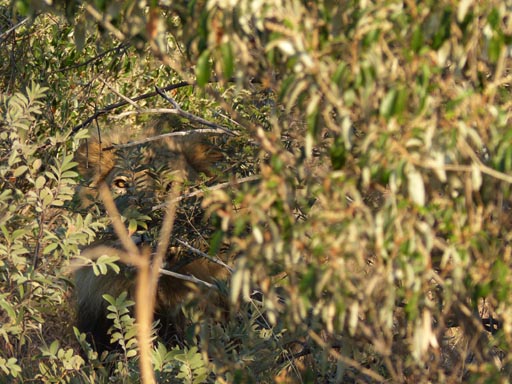
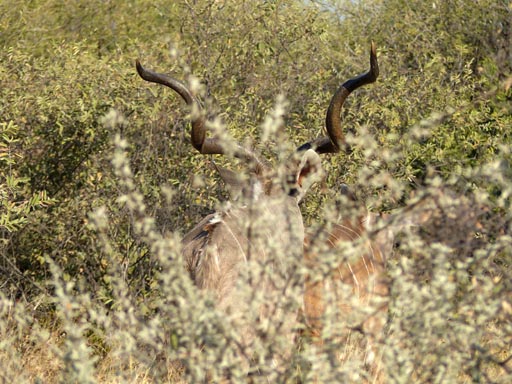

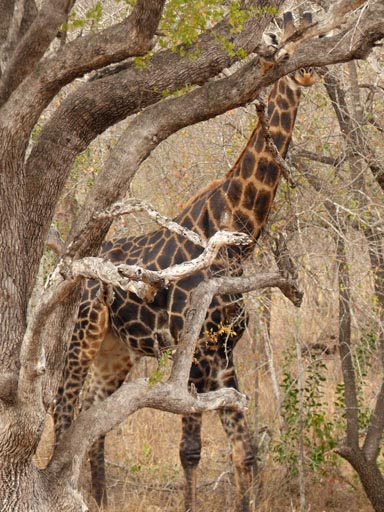
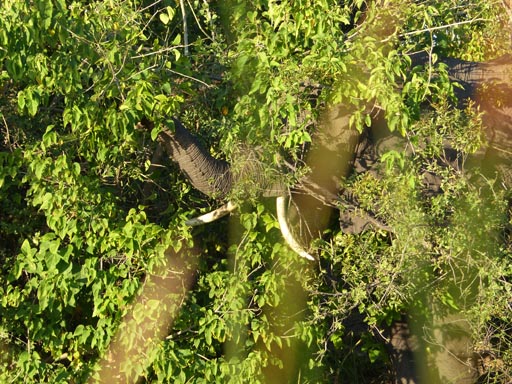

Day 28
Today's morning walk is around the historic center of Stellenbosch. It is very stylish and attractive, posh even. Think Carmel California at a relaxed pace (it is low season). Cafes, galleries, gardens, fashionable shops, and so on. We buy some gifts and have lunch at a sidewalk cafe. We chat about the fact that we have gone from the wildest wilds to the most civilized civilization in one jump. It takes a bit of getting used to. I am in game drive or waterhole withdrawal.
To make some adjustment, the afternoon walk is at the Jonkershoek Nature Reserve just outside of town. Unfortunately the reserve was damaged by fire in March. The remains of what must have been an incredible protea forest line the trail. The proteas were in flower when the fire hit. I can only imagine that it would have been spectacular. A few islands of protea remain, and the fire lily is growing fast, so with them, the mountains, the creek, a waterfall, the fresh air, and the chance to stretch our legs, the walk is well worthwhile.
When we return to the B&B I discover that they have grabbed my laundry bag and the jumble of clothes around my bag and done my laundry. It is all nicely folded on the chair. What an unexpected pleasure. Cliff is flabbergasted as his socks and underwear have been hanging over the tub for a day and a half! He has another good laugh and rushes off to get them dried. Aren't we spoiled.
Dinner is again at Oppie Dorp, and again without a glance at the dessert menu.
Burned out protea and local flower
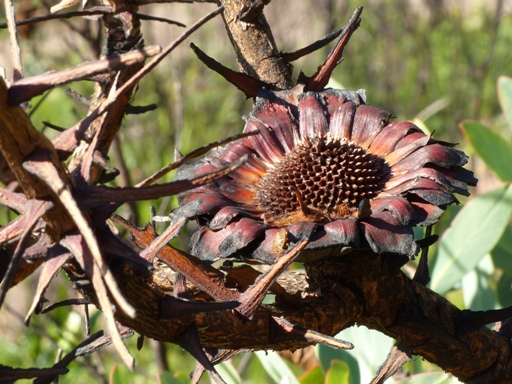
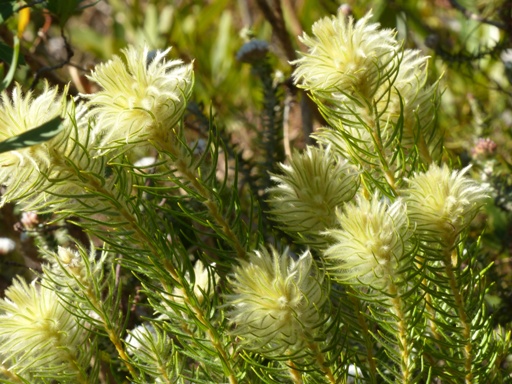
Day 29
On Day 29 we swing and miss twice, but it all works out ok.
We get an early start from Stellenbosch and experience a bit more of civilization by catching the tail end of the Cape Town morning rush hour as we head to Table Mountain. We plan to ride the cable car, but it is closed for maintenance. Strike one.
But, no matter, we cruise around Table Mountain National Park visiting various scenic overlooks and soaking up the local colour. We check into the B&B and decide to take the Robben Island tour in the afternoon. We get to the dockside at 1pm only to find that the last tour is sold out. Strike two.
But, no matter, we have lunch at one of the many cafes in the Victoria and Alfred waterfront, check out the African Trading Port, and do some "souvie" and gift shopping.
Dinner that evening is at The Miller's Thumb, which is less than 100 meters from the B&B and claims on their website to be "the best place to eat on earth". I'm not completely convinced that they are wrong. I try to book for tomorrow night, but Cliff won't let me.
Panorama of Cape Town from Signal Hill; Do-it-yourself Table Mountain "postcard"; native flora

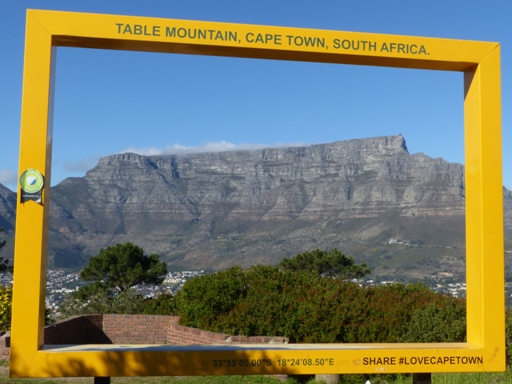
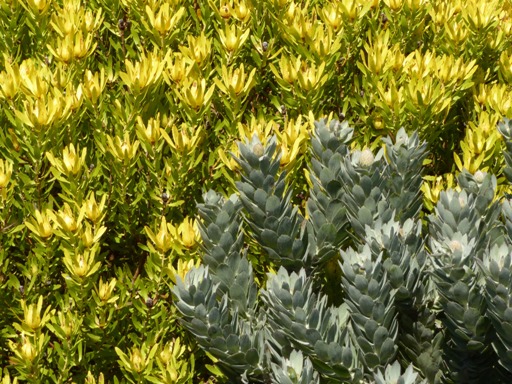
Day 30
We awake to discover that it has rained overnight, but the clouds are allowing some "sunbreaks" as we set off on our tour of the cape peninsula. First stop is the excellent Kirstenbosch botanic gardens, which are a marvel in winter, as must be even better in summer. King protea in bloom, and much more. Next stop is the small African penguin colony at the Boulders - not much happening, but still fun. Then on to the Cape of Good Hope. The visitor center sign says that the Cape itself is a 90 minute round trip walk away. The weather is iffy, so I dither a bit, but then can see that we are in a sunbreak, so decide to go for it. It is cold, and the wind is howling, but you wouldn't want a visit to the ends of the earth to be any different, really, would you? The track is easy and well maintained, so quite soon I reach the Cape itself. I clamber over the last few rocks and gaze out to the wild seas, and to the tourist busses parked immediately below! Bugger! I should have checked the map first. It turns out that you can drive to the foot of the Cape. I have the satisfaction of knowing that I am slightly south of them, but only just. I tell myself that it was worth it for the wild and untamed experience of the walk, which it was, and then walk back to drive down to join the tour busses at the official signpost. Sigh.
Dinner at Arnold's is lively and tasty - and with the voucher from the B&B includes a free bottle of the house red.
King protea; penguins; The Cape of Good Hope; wind blown breaker off the Cape
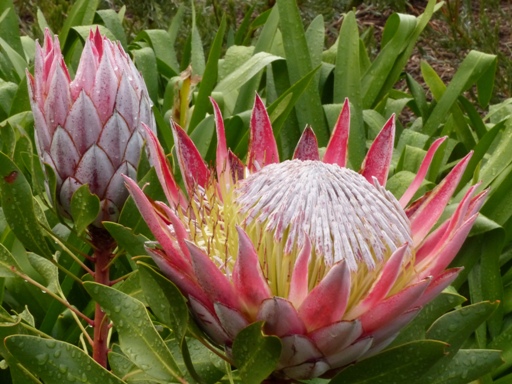
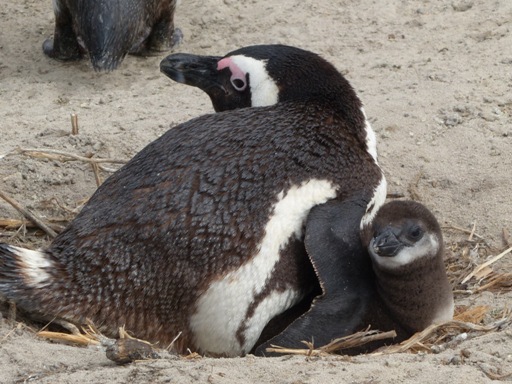
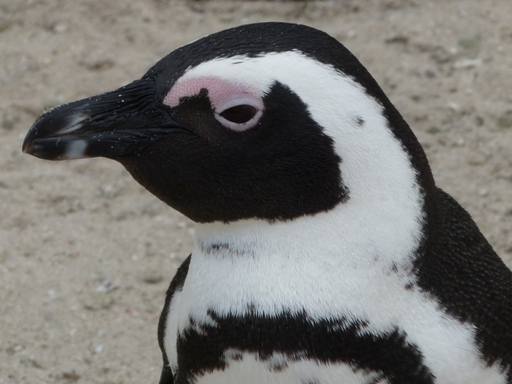
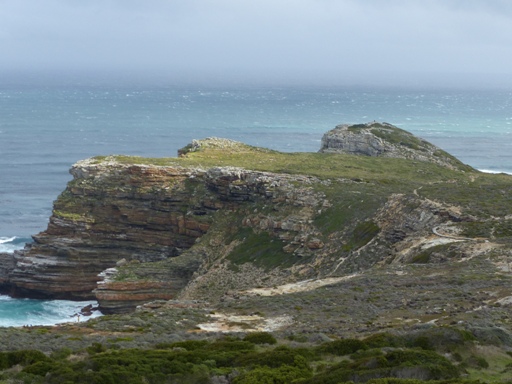
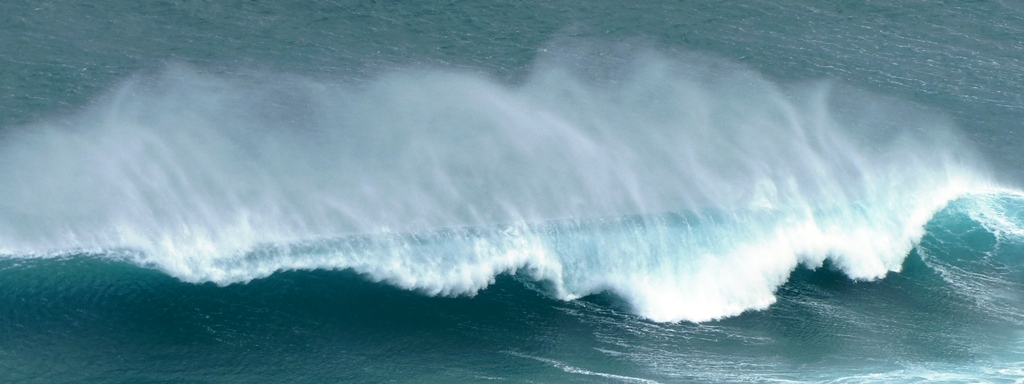
The Day 30 video is of the penguins and the wild wind and surf at the Cape - spot the cormorant flying backwards (2:12)
Day 31
Once again it has rained overnight, poured in fact. It is cold and windy in the morning. As a result, and due to rough seas, our tour to Robben Island is cancelled. When we try to book for tomorrow, we find that the 9am tour is completely full. Since we leave in the afternoon we will miss out entirely on the tour. A pity.
Still, the weather clears quickly and we maintain our perfect record of no rain during any day of this trip. We do a walking tour of downtown Cape Town; spend a few hours in the Museum of South Africa, including. A tour of an outstanding collection of nature photographs; and call into the offices of our travel agent, Rhino Africa, to meet Sian (email: sian@rhinoafrica.com), who put the tour together for us.
I am a generally forgetful person, but, despite a couple of close calls, have managed to not lose anything so far. Today I accidently donate my black beanie to Africa. I hope that it finds a needy head to keep warm.
Neither of us are city people, and we quickly bore with pounding the pavement. By mid afternoon we are back at the B&B. The tour looks like ending with a whimper instead of a bang. So, to counteract this we book a late table at Mama Africa's, a popular bar/restaurant/club with local music.
The food at Mama's turns out to be pretty good, and some of the people watching interesting, but the whole atmosphere is rather subdued. The band is energetic, but at best only OK and not at all African (they played "I just called to say I love you" and "Guantanamera"! - albeit with extra drums). Oh well, at least we tried.
Blue whale skeleton in the museum
Day 32 - Departure Day - July 31
We get our latest start of the trip as our flights are not until the afternoon and we don't really have a plan. After checkout we decide to go north along the coast, having already been east and south, and west being a bit wet. The day is cool with blue skies and fluffy white clouds. The area in the northern suburbs is very genteel, and the beaches long, white and beautiful. We are not set up for beach walking or swimming, so resort to the Points of Interest in the GPS system and randomly pick a nearby nature reserve, figuring we can at least get a walk and some fresh air. When we arrive, the place is a very nice wetlands and bird sanctuary, complete with hides. We stroll out to the hides using a long boardwalk. As we walk we hear the cry of a fish eagle, one of Cliff's favorite African sounds. We look up and see two eagles circling high above. Have they come to farewell Cliff? The marsh is alive with the tinkle of the little chiming frogs that I had enjoyed so much from the Okavango. Have they come to farewell me? When we get to the end of the boardwalk, the sign on the side of the shed says Old Friends Hide. It is unbelievably perfect for us and the Africa Obscured theme of Cliff's! Somehow we were meant to find this place. We may not understand the forces that control the universe, but sometimes at least, they do have a sense of humor.
We spend a nice while watching the birds, seeing several new species for the trip. Then off to the airport.
Along the way we pass beside a township area and see the shacks and poverty that we had not encountered before then. I lock the doors when a sign at a stoplight warns that this a high smash and grab risk area.
My flight to Jo'burg is on time, so I farewell Cliff and head for the gate as he has a few hours to wait before his flight to London.
At O R Tambo airport I complete my loop around southern Africa and head home.
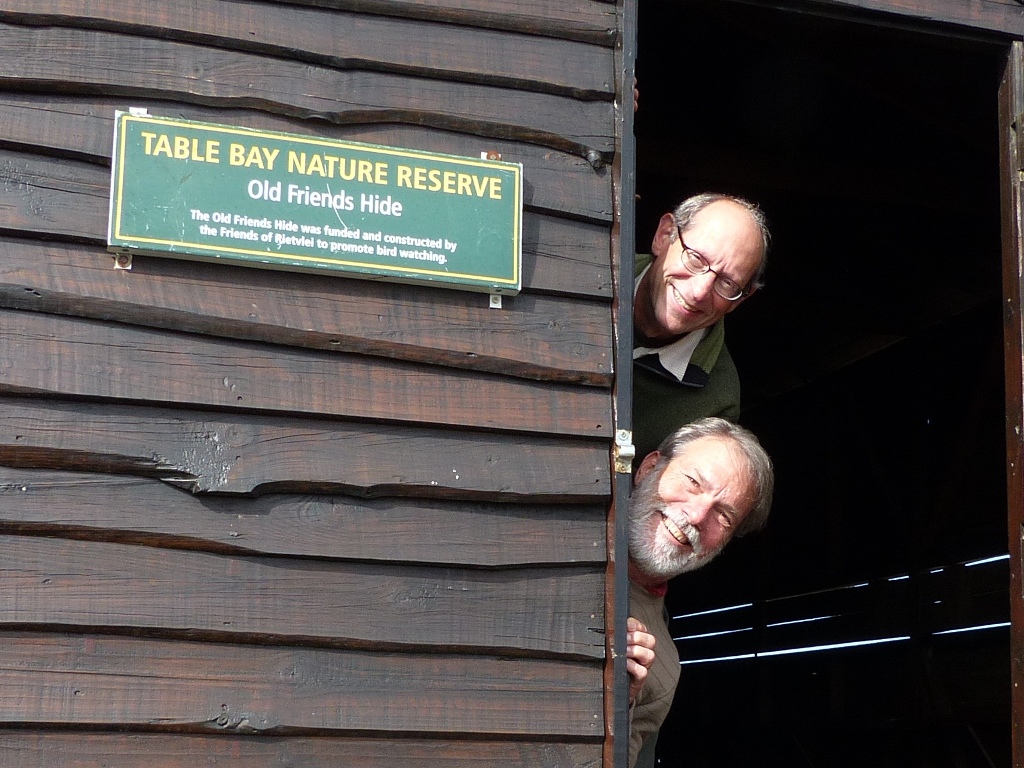
Afterward
I write this in the air between Auckland and Christchurch, being the last leg of the journey. This does not allow sufficient time for reflection, but I have decided to include the words from this journal verbatim, as a snapshot in time like the photos and the videos. So here goes.
I first visited Africa in 1984. My trip through East Africa then was so enjoyable that I have been wanting to visit Southern Africa ever since. So, I am extremely glad to have finally made it, and especially glad to have done so in the company of Cliff.
I don't share Cliff's passion for Africa, but I do have a passion to see, explore and understand the wildernesses of the earth. Every continent, every place, has its own unique wonders and stories. But, Africa is a world of its own. It is the birthplace of man, from which we have emerged to overrun the planet. Possibly as a result of this, it seems to me that the wild places and animals that evolved with man retain more of their primitive character than other places. Outside of the polar regions, no where else on earth is as much like it always was as Africa.
In many places, including New Zealand, introduced species, including man, have wrecked havoc. In Africa this hasn't happened to the same extent, maybe because the introduced species can't outcompete the hardened Africans and are "gone by lunchtime". I trivialize to some extent, but the kernel of truth is there.
Meanwhile, the wild places and man have somehow come to terms, or are coming to terms. People like me come to marvel at the wilderness, while eating great food, driving the countryside, and having hot water bottles in our beds. No doubt the wilderness has adapted to our presence, but it seems to be coping well as far as I can see. Limits are placed on the number of visitors, and Africa is a big empty place. Hopefully some appropriate balance can continue to be struck into the future.
Jaco at Deception Valley perhaps said it best when he observed that he feels bad about intruding into the life of the lion we tracked. He rationalizes it by seeing it as the rent that the lion has to pay for the kudu that are attracted to the waterholes he maintains. Neither the lion nor the kudu nor Jaco and his lodge would be there if people like Cliff and me didn't pay to be there. So, we have altered the Kalahari, but not in a way that I am distressed about.
Prior to the trip I had a fair bit of angst about its self indulgent nature. I am over this now. I accept that I am lucky enough to live my life in a time and place that allows me this opportunity. I would not benefit anyone by not taking it. I am hurting no one by taking it. I may even be enough of a Reaganomic trickle-down economist to think that the money we spent has benefited the people and wild places of Africa. Certainly it helps them more than if we spent it somewhere else.
I noted several times that we never saw any real poverty. I think that this is a result of the places we went and the style of our trip. There were beggars and street people in the cities, but no more so than in western cities I have visited. Everywhere everyone was trying to find their own way to survive; street peddlers; parking wardens and guards; porters; and so on. So good on them. I never felt threatened or in danger. Some places were fortified with barbed wire and guards, especially Jo'burg and Windhoek, but most places were quite normal. Cape Town and Stellenbosch in particular seem quite nice cities. Again, this is likely based on an incomplete sample, but that is the way it seemed to me.
So, there you have it. If you have any thoughts of traveling to Africa then I suggest that you contact Cliff or Sian and go for it.
Pula!